
PROFESSIONAL M OTOR M ECHANIC



ENTER THE CPD ZONE! YOU COULD EARN ONE CPD CREDIT THIS MONTH
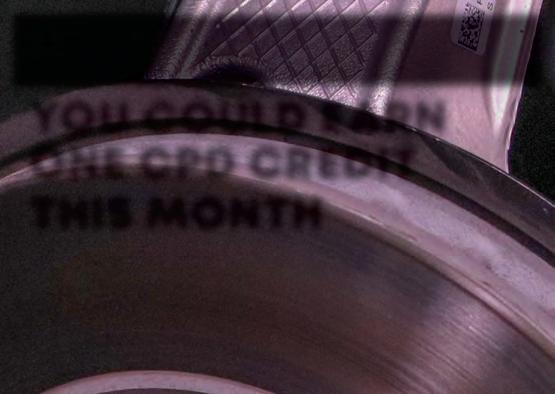
Let’s get technical:
AN AUDI A4 HAS ITS DMF REPLACED
CABIN AIR FILTRATION EXPLORED
WHAT ROLE DO 12V BATTERIES PLAY IN EVS


COULD MOT TRAINING BE BETTER?
CHECK OUT JEN FROM HR VITALS’ NEW REGULAR COLUMN WIN A DAY AT THE RACES WITH KALIMEX

NOT GOING ANYWHERE: BELT-IN-OIL TIMING DRIVES
STABILISER BARS, BALL JOINTS, EV SUSPENSION AND MORE!

FREE TOTHE TRADE PMM
2024
JUNE

Editor’s Picks
22 TAKING CHARGE
As part of this month’s CPD Zone, automotive battery specialist Varta is taking readers through the importance of the traditional 12V battery as the UK heads towards an electric future. Make sure to scan to QR code at the end of this feature to claim your CPD point.
31 WORKING WITH OTHERS
Looking for some top tips from the aftermarket’s HR expert? Look no further than our new regular column from Jennifer Webb, owner and director of HR Vitals.
Sitting pride of place in our bumper diagnostics and engine management feature is an article from Pico’s technology specialist Steve Smith, providing us with a comprehensive guide on how to do oscilloscope diagnostics with some best practice tips.
PMM has a rare prize opportunity for one lucky reader and their family to spend a day with a world championship winning race team, thanks to sponsors Kalimex! Turn to page 59 of the magazine to find out how to enter.

Features
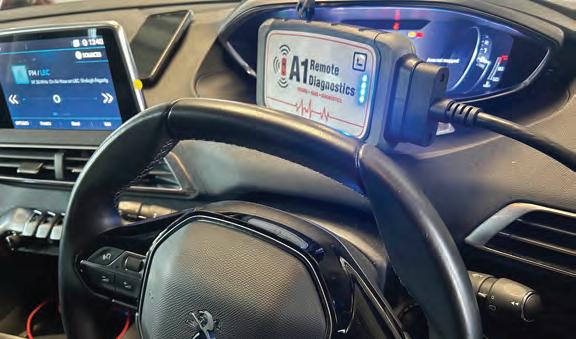
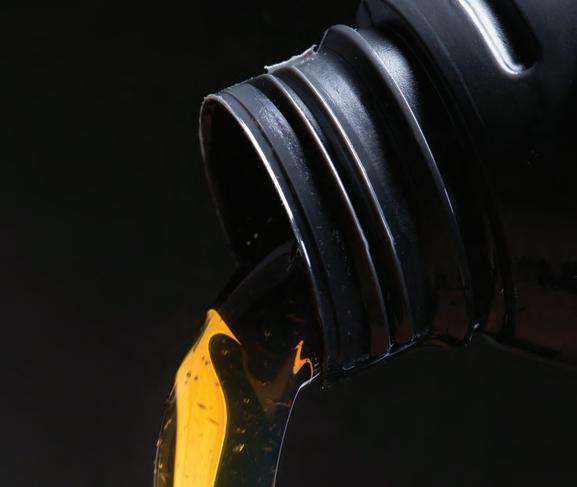
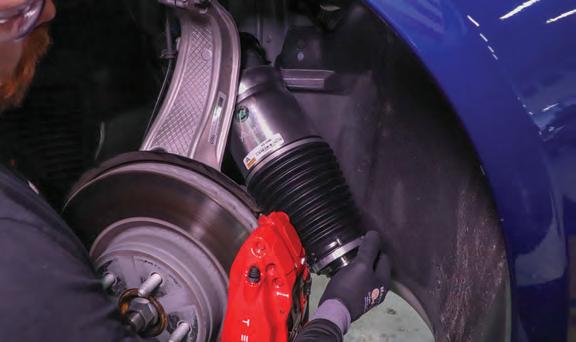
Contents VOLUME 25 ISSUE 6 JUNE 2024
Total Average Net Distribution 53,353 1st July 2022 – 30th June 2023 PMM JUNE 2024 3
6-9 NEWS & VIEWS 10 PMM PODCAST: THE BEST BITS 13-29 CPD ZONE 30 PIT STOP 31-33 SPECIAL REPORTS 61-65 IN THE WORKSHOP
Regulars
39 OSCILLOSCOPE DIAGNOSTICS GUIDE
59 WIN!
44-51 OILS, LUBRICANTS & ADDITIVES 35-43 DIAGNOSTICS & ENGINE MANAGEMENT 52-57 STEERING & SUSPENSION

Editor KIERAN NEE
News and Products Editor
FREYA COLEMAN
Digital Manager
KELLY NEWSTEAD
Group Manager
ROBERT GILHAM
Senior Account Manager
ALEX DILLEIGH
Magazine Designer
GEMMA WATSON
Group Production Manager
CAROL PADGETT
Production Assistant
CLAIRE SWENDELL
Distribution Manager
KARL CLARK
Subscriptions
PROFESSIONAL MOTOR MECHANIC is a business magazine for firms and individuals involved in all aspects of the motor trade. It is published eleven times a year and is available nationally FREE to the trade through leading motor factors. It is also available through the post at a cost of £30.
EUROPE and OVERSEAS
UK £30 post paid
Air mail
£80 post paid
Europe £50 post paid
Printed by
PCP Telford
Published by
HAMERVILLE MEDIA GROUP
Regal House, Regal Way, Watford, Herts, WD24 4YF. Tel: Watford (01923) 237799 Fax: (01923) 246901
E-mail: pmm@hamerville.co.uk
Sales enquiries: pmmsales@hamerville.co.uk Website: www.pmmonline.co.uk
Copyright © 2024


WHEEL OF FORTUNE
We could be gearing up for a general election by the time you’re reading this, as at the time of writing, Rwanda Rishi is refusing to rule out a summer vote. Also at the time of writing, it’s starting to look like a Labour landslide in the local elections. Either way, one thing I can be confident of is that by June, both parties (there are more than two?) will be in full battle mode, fighting for the hearts and minds of UK voters. I would say they’ll be fighting for our wallets too, but both parties have acknowledged that wallets (and coffers) are rather light these days and that that’s unlikely to change much, whatever the outcome.
We’re just coming out of a high employment period in which jobs were seemingly there for the taking, but now the “phantom” recession is starting to take hold and the economic seesaw tilts back again from ‘high inflation’ to ‘fewer jobs’. You can’t have both affordable goods and money to pay for them at the same time, it seems, but don’t worry, it’s only a technical recession. You’ll only ‘technically’ be losing your job.
All this doesn’t apply, thankfully, to workers in the automotive independent aftermarket. The previous years of economic hardship have meant that drivers have been repairing rather than replacing their cars and, what’s more, supply chain issues have meant that new cars just haven’t been available for those who have replaced. All in all, the UK car parc has never been older and never been in need of more repair.
In turn, garages have never been busier, with no shortage of cars needing servicing and repair. Does this mean, then, that garage owners are enjoying the good times? Does this mean that when you are asked, repeatedly this summer, whether you are better off now than you were prior to... well, prior to something (it's hard to see where either political party will draw the line to make themselves look good), you will respond yes, indeed, my garage has never been so busy and by the simple laws of finance, I have never earned so much profit. Unlikely.
More likely is that most of you will be in a position where you are having to turn work down because you haven’t got the staff, you are having to prioritise time-consuming work over profitable jobs and what extra profit you are making is quickly being lost to inflation, rising rents, living costs and that’s not to mention the plethora of industry-specific costs which seem to pile on from nowhere.
Being busy is a poor indicator of profit, just as high employment is a poor indicator of growth when the majority of those jobs are zero hours, zero pride, zero hope. It’s time quality was priveliged over quantity and that’s something all of us could work on this summer.
KieranNee Editor





VIEWPOINT
The publishers and editor do not necessarily agree with the views expressed by contributors,nor do they accept responsibility for any errors of translation in the subject matter in this publication. Listen on Amazon Podcasts Listen on Spotify Podcasts Listen on Apple Podcasts Associate member Find every episode at www.pmmonline.co.uk/podcasts Also available: JOIN M E EACH M ONTH ON THE PMM PODCAST
PMM NEWS
NEWSIN BRIEF
■ NORTHERN IRELAND MOT EXEMPTION CERTIFICATES
ISSUED The infrastructure minister John O’Dowd has announced temporary on-year MOT exemption certificates for cars aged between five and seven years old in an aim to tackle the current test backlog.
■ DIGITAL MOT CERTIFICATES
ISSUED The DVSA has announced that drivers can access MOT pass certificates digitally, by default, at the time of the test, rather than waiting for the official letter.
■ FAMILY GARAGE BREAK IN Wellington Garage in Middlesbrough has been left devasted after a late-night break in. The business that has been serving Teesside motorists for the last six decades saw the loss of three snap-on toolboxes with a potential replacement value of over £40,000.
■ RING AUTOMOTIVE TURNS 50 To celebrate, Ring is ensuring its 50th year is memorable for everyone associated with the company. Included in the celebrations, the team has produced unique limited-edition gifts for customers with a custom designed Lego kit and a specially brewed Yorkshire beer.

with Freya Coleman
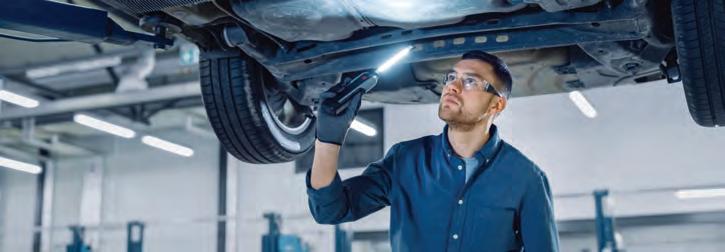
Complaints on the rise
The Motor Ombudsman has recorded the highest ever volume of service and repair cases brought by consumers to its dispute resolution service in a single quarter.
Between 1st January and 31st March 2024, 1,604 new cases about routine and ad hoc maintenance conducted by repairers were logged by motorists under The Motor Ombudsman’s Motor Industry Code of Practice for Service and Repair. This equates to a 35 per cent rise versus the opening three months of 2023 (1,189) and surpasses the
Diversity insights
Insight from the IMI’s diversity task force, published in its latest report reveals a more positive picture of diversity in many areas, but female representation is still lacking.
The proportion of automotive employees with a disability has increased since the force’s first report in 2022, as has the
previous high of 1,372 seen in the fourth quarter of 2023.
Service and repair disputes have accounted for nearly a fifth of the total cases opened by consumers during the first quarter of 2024. Similarly, phone calls from consumers were received during the same period increased by 56 per cent compared to January to March 2023. The notable year-on-year jump in demand is said to most likely be a reflection of the sustained financial pressures on consumers from the heightened cost of living.
proportion of non-white British employees. However, female representation in the workforce has taken a backward step compared to the 2022 report. Based on these findings the professional body is urging employers and individuals to get involved in the IMI diversity task force working group.
Driving Towards Inclusion: Key findings
■ The proportion of female employees across the whole industry has fallen by 2.1 per cent over the past two years, now standing at 17.5 per cent.
■ 15.5 per cent of automotive workers have a disability, 2.2 per cent higher than in 2022.
■ Ethnic diversity has increased by 1.1 per cent compared to the 2022 report to 13 per cent – however the automotive
sector remains behind the UK where 18 per cent of the general working-age population is non-white British.
■ The female automotive workforce is statistically younger and more ethnically diverse than males.
■ Males with disabilities and non-white British males are under-represented in automotive.
6 JUNE 2024 PMM
in
association with

FOR UP-TO-DATE NEWS, SIGN UP FOR OUR WEEKLY E-NEWSLETTER. SIMPLY SCAN THE QR CODE
Matching BEV and ICE vehicle prices
According to a new white paper released by Indicata, there is indication that prices of some used battery electric vehicles and ICE cars are starting to equal each other in Q1 of 2024.
Entitled ‘Reaching used BEV and ICE car price parity’ the white paper follows used retail car prices of all fuel types from 2020-2024. This includes using its data to track used prices of five popular BEVs from Citroen, MG, Vauxhall, Peugeot and Hyundai against their equivalent ICE models. Dean Merritt from Indicata said: “Price
parity is vital for BEVs in the used market as consumers are now being offered all the latest fuel types at similar prices, where before used BEVs were commanding a 25-30 per cent price premium which put buyers off going electric.”
One example listed was a Citroen C4 BEV vs a two-year-old C4 with 20,000 miles. The Citroen C4 BEV reached price parity with its diesel equivalent in May 2023 at £17,400 but prices continued to fall. As of March 2024, BEVs were worth £14,200 against £16,200 for the diesel.

IMI-approved Hella academy opens
The PMM team were on hand to witness the opening of the new Hella Academy, which has been given the official thumbs up from the IMI. Whilst there, Hella’s technical team gave the journos in attendance much food for thought on the thorny issues surrounding cyber security. Representatives from the IMI were at the event, where the certificate and plaque confirming IMI centre status was presented to Steve Fox, training manager at Hella Academy. He said: “This is a momentous day for all of us at Hella Academy. Much work has gone into putting together this
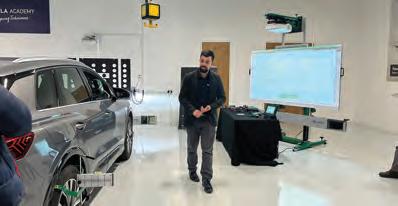
brand-new training centre. We can now work to support the sector up-skill, with the initial focus on advanced driver assistance systems.”
 In pictures: Motul has been announced as a Circuit Partner & Event Sponsor of Wiltshire’s Castle Combe Circuit for the 2024 season.
In pictures: Motul has been announced as a Circuit Partner & Event Sponsor of Wiltshire’s Castle Combe Circuit for the 2024 season.
PMM NEWS with Freya Coleman
NEWSIN NUMBERS
53 %
of drivers say the rising cost of petrol and diesel is their biggest car concern, followed by insurance (52 per cent) and MOT servicing (37 per cent). This is according to research conducted by Close Brothers Motor Finance.
£ 941
is now the average price of car insurance in the UK, increasing by 43 per cent in the past 12 months according to the latest Confused.com car price index.
79 %
of drivers prefer buttons over screens for essential controls in their car, shows April’s new Startline Used Car Tracker with only 51 per cent believing that having all controls on touchscreens is safe.
50,776
MOT appointments were missed across Northern Ireland in 2022/23, which comes after the chief executive of the DVA said motorists face an average wait of 72 days for MOT tests.

Jump starting battery woes
In a recent post on the online biking forum Singletrack World, one unfortunate user told a shocking tale of how a routune service at a Halfords service centre has potentially ended in disaster for their car.
Asking fellow users whether Halfords had “killed” their car, the worried poster detailed how their woes began when their Renault Grand Scenic’s battery needed a jump start: “It went into Halfords for an interim service and MOT last week, had to replace one tyre, the ball joints and suspension arms (which hurt) but otherwise fine.”
A few days later, the battery was gone again. The poster called the same people to jump start their car again but this time it doesn’t start back up and “dies altogether”, with all dash lighting completely dead. The engine eventually restarts, but sounds “really rough”. They continue “Helper guy drives off and I try to go home – no power! The car sounds awful and won’t get above 20mph. Also, the dash lights up with warning
Big car ban?
April’s Startline Used Car trackers has shown that six out of ten people believe that drivers of four by fours and other large cars should pay more to park in city centres.
This question was asked following the news that parking charges in Paris have been trebled for any vehicle weighing more than

messages: the ‘needs service’ light comes back, I also briefly see a message to check the injectors. The car’s now at home. Called Halfords, they say the battery seemed fine when they checked it, no other comment unless I bring it in again.”
They finish the post by asking if Halfords caused the car’s problems, or if it’s the engine or electronics. The responses to the post by other users were mixed, one urging the original poster to “get it to a trusted local garage to check it out”, others insisting on a battery replacement or arguing that Renaults have notoriously ‘dodgy electrics”. Either way, it’s hard to say who is at fault!
1.6 tonnes. The company wanted to see if there was an appetite for this French move here in the UK and the answer was found to be ‘oui’, with 37 per cent saying that these vehicles are too big for city streets and are too polluting.
Mechanex returns to Sandown Park

Following the success of heading up north to the Yorkshire events centre in Harrogate. Mechanex PMM Live, the UK’s longestrunning trade show dedicated solely to the independent aftermarket is headed back to Sandown Park in Surrey on the 12th and 13th of November. Exhibitors anounced so far include Opus IVS, Motul and Bosch. The event is free to attend (and so are the bacon rolls!) so scan the QR code to register now.
8 JUNE 2024 PMM
in association with
News in quotes
“EVs will be part of the picture, of course they are. But at the current rate of electrification even if we could keep it up – which we can’t because China is withholding the rare earth minerals we need – by 2050 the majority of cars on the road will still be, and have to be, internal combustion engines. So we have to solve that, and synthetic fuels will be the way.” Richard Hammond, journalist and TV presenter.
Mental health MOT
The automotive charity Ben has announced it will be launching health checks for automotive people, offering the chance for those who work in the industry to have a personal MOT for their physical and mental health.
Ben health checks can be booked by any automotive employer wanting to invest in the health and wellbeing of their employees. In today’s fast-paced world and work environment, with multiple additional challenges, prioritising employee health and wellbeing has never been more important for any business. This is further supported by results from Ben’s health and wellbeing survey which indicated 99 per cent of respondents said they had experienced an issue with their

health or wellbeing over the past 12 months. The health checks offer the opportunity for automotive employees to have one-onone conversations about their physical and mental health with a qualified health professional and also identify potential issues and suggest making positive changes so people can live and work well.
DATES FORTHE DIARY
■ The IAAF is launching its inaugural Summer Conference and Networking Event, taking place on Wednesday the 12th June at The Belfry, West Midlands . The event will be IAAF’s first member Summer Conference in over a decade and will feature key guest speakers from within the automotive industry and beyond, as it looks at how the sector can inspire, nurture and develop talent. Members will have the opportunity to network with other likeminded professionals and take away key insights on skills, training and recruitment from leading aftermarket speakers.
■ Schaeffler has announced its upcoming REPXPERT 2CT training course is scheduled to take place on 16th - 17th July, at the South Devon College Skills Academy in Newton Abbot, Devon. The two-day course combines theory with hands-on practice to equip technicians with the confidence and repair solutions needed to efficiently undertake VW double clutch system repairs.

MESSAGE ME YOUR NEWS AT FCOLEMAN@HAMERVILLE.CO.UK

A look inside:
PMM THE PODCAST




MOT Tester training – needs fixing?
LM: As a mechanic myself I left school with “some” qualifications – I wasn't very academic. I got into the industry because I was good with my hands and knew and understood how things worked; I couldn't tell you how they worked, I couldn’t write it down, not in a very good format. But now, as MOT testers we’re expected to be more academic, to do those minimum hours of training a year, to keep a training log, to read some very awkwardly worded questions sometimes and give awkwardly worded answers and that’s what people dread. It takes you back to school, to your exam days, with the fear of having to sit in a hall full of hundreds of students and sit quietly and write a paper. I think that’s what a lot of testers still do now. And we do have testers
with learning disabilities, dyslexia and such like. And I don’t think the annual assessment and online assessment is geared up for those people.
I think that the training has certainly slid since DVSA relinquished the training inhouse. The message was consistent back before 2016. We did our five-year refreshers. We had to go to DVSA or VOSA back then for two days. You met like-minded people, you discussed other situations... In that environment, you were free to talk, whereas now the online assessment is sold as flexibility – you can do it at home, you can do it at work, you can do it at the weekend. That does suit some people, absolutely, but we always get the feedback that the old way was better.
The most recent episode of the PMM Podcast is focused on the MOT, how the training is administered and what needs to change to improve engagement with the testers themselves. Here, we take a sample of the conversation Kieran had with Leigh Marsden and Kallum Dorman from Protech Academy, an MOT training organisation.
Face-to-face training
KD: With face-to-face training you can ask questions to a trainer like myself and Lee.
LM: I don't think testers get the support like they used to you know back in the day of the vehicle inspectorate and VOSA. There were vehicle examiners that used to visit the garages quite often and they were a form of education. You could ask the
The DVSA needs to be reaching out to the industry more?
LM: I think they definitely need to do more. I think they need to engage more with the garages, listening to the boots on the ground and actually at the coal face, vehicle examiners aren't visiting the garages as we know, like they used to. And I don't think that testers are being listened to, especially around the annual training. I think there are a lot of complaints about how it's done and how long they've got to do it and it’s absolutely a valid point that DVSA is

vehicle examiner and garages would be looking forward to seeing the vehicle examiner in some cases because they had a burning issue. Some not so much, I’m sure! But also you used to have the vehicle examiner’s phone number and you could ring the vehicle examiner and ask him the question and he would answer you and they were very experienced guys.

expecting these testers to do this annually with little resource other than any learning package.
TO LISTEN TO ALL OF THE EPISODES SO FAR ON THE PLATFORM OF YOUR CHOICE, SIMPLY SCAN THE QR CODE
10 JUNE 2024 PMM
Leigh inspects our microphone with suspicion

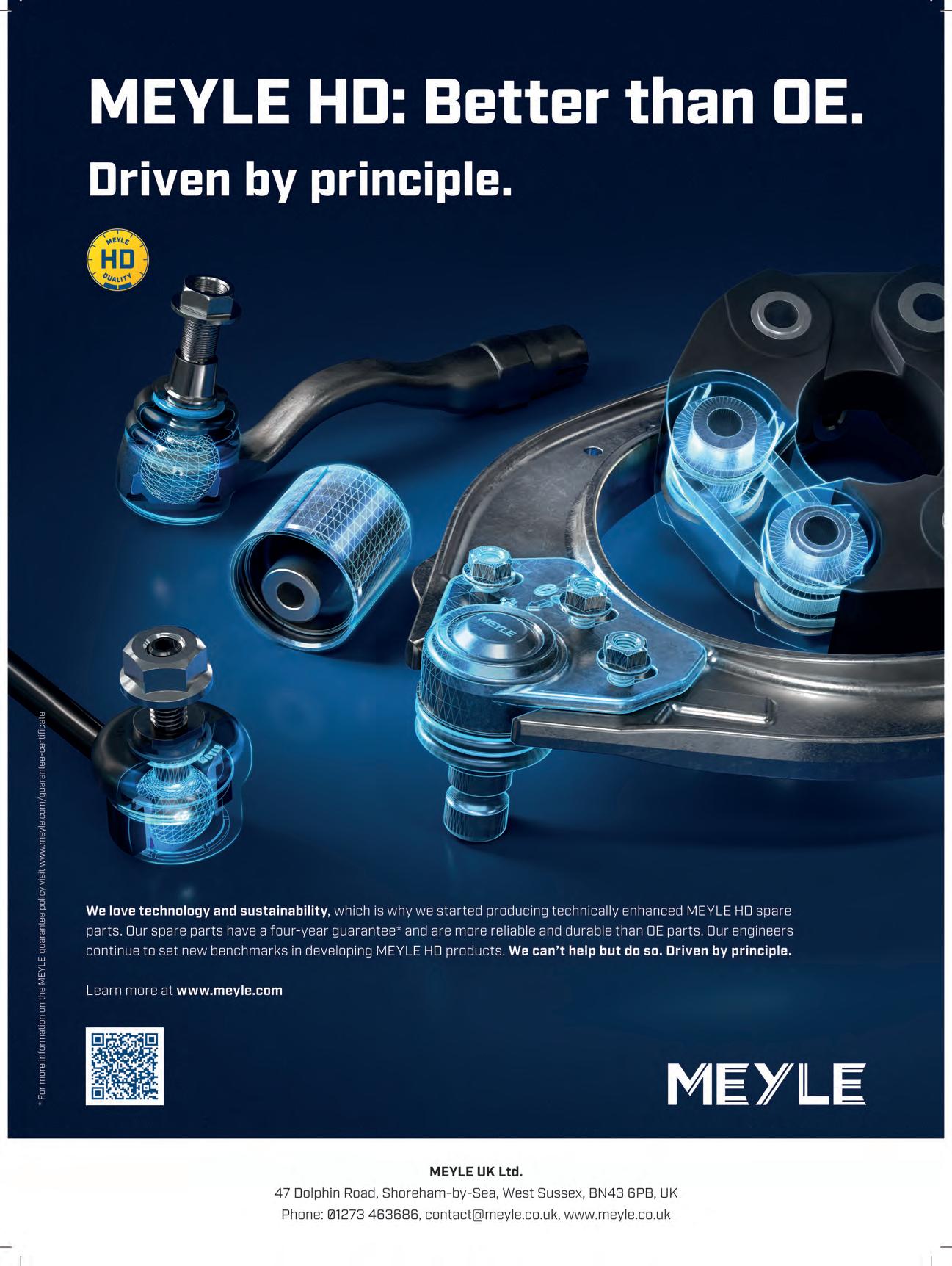
YOU ARE NOW ENTERING


PMM has teamed up with the CPD Group to offer you the chance to gain CPD points while you read every issue!



Continuing professional development (CPD) can be broadly defined as any type of learning you undertake which increases your knowledge, understanding and experience of a subject area and your role within it. To help professionals to better document and prove this process, our new CPD Zone features articles that have been checked, verified and accredited by a thirdparty specialist organisation.

The content within the CPD Zone will provide you with 1 CPD Credit, or 1 hour’s worth of continuous professional development.
Once you have read through the articles contained within, you will be able to scan the QR code at the end of the last article. This will provide you with a downloadable certificate, personalised to you. This can then be used as part of your ongoing CPD record, as needed to satisfy various organisations and schemes. Regular readers of PMM, therefore, could earn 11 CPD points just by reading the magazine each month.
DO NOT SCAN THE QR CODE UNLESS YOU HAVE READ ALL OF THE CONTENT WITHIN THIS SECTION!
CPD relies on self-certification, which in turn relies on professionalism and honesty from those who participate. We have great faith in the diligence and professionalism of our readers – we are called Professional Motor Mechanic, after all. It is fairly safe to assume that if you are picking up PMM each month, then you are already interested in reading and understanding technical content. Indeed, we are a lifeline for many in the industry who rely on us to spread the word on the latest changes and developments originating with the OEMs.
THIS PROCESS IS COMPLETELY FREE
Don’t worry – you won’t have to pay a penny to gain your CPD points each month. It’s on us!
All certificates are valid for one year from the issue date. If you have any issues downloading the certificate or using the system please email us at: pmm@hamerville.co.uk
NEW USERS –
ACCESS YOUR BESPOKE CPD CERTIFICATE IN FIVE STEPS
Read ALL of the articles within this month’s CPD Zone
Scan the QR code or enter the RDR.Link in your web browser –both are found at the end of the last article in this section
Enter your email address
Fill out your details on the contact form
Download your certificate for use as part of your annual CPD record
PREVIOUS USERS –ACCESS YOUR CPD CERTIFICATE IN FOUR STEPS
Read ALL of the articles within this month’s CPD Zone
Scan the QR code or enter the RDR.Link in your web browser –both are found at the end of the last article in this section
Enter your name and email address
Download your certificate for use as part of your annual CPD record
PMM JUNE 2024 13
READ ME TO COLLECT YOUR CPD POINT CPDZONE



PMM THE PODCAST

WHAT DO CHANGING A BATTERY, CHANGING A BABY (JUST THE NAPPY) AND CHANGING YOUR MORNING RADIO STATION ALL HAVE IN COMMON?
THEY OFFER THE PERFECT OPPORTUNITY TO LISTEN TO THE PROFESSIONAL MOTOR MECHANIC PODCAST WITH KIERAN NEE.
HEAR ADVICE ON PRICING JOBS, MANAGING PARTS SUPPLY, ELECTRIFICATION, RECRUITMENT AND MUCH MORE.


LISTEN NOW ON YOUR PODCAST PLATFORM OF CHOICE





Listen on Google Podcasts Listen on Apple Podcasts Listen on Amazon Podcasts Listen on Spotify Podcasts
TROUBLESHOOTER
What was wrong with the engine on this BMW N20?
PMM ’s troubled troubleshooter Ben Johnson stambles through numerous fault codes and takes a look at fixing a BMW N20 that staggered its way into his workshop.
It’s a rarity these days, a genuine anomaly, to have a vehicle stagger into the shop, presenting a problem more intriguing than the textbook misfire caused by a rebellious coil or an injector shedding more tears than a reality show contestant on the brink of being sent home. So when this particular vehicle was towed in, I was already convinced that a mundane misfire wouldn't be on the day’s agenda. Such was my conviction until I perused the epic tale etched across the job card, a veritable odyssey of mishaps. After battling through the dense Finnish prose, converting into English as I went, I was left with only the remotest possibility of an easy passage home. My woes were matched only by those of the vehicle’s owner, who had, in a burst of optimism, attempted to clinch the pole position at the impromptu Vantaa Grand Prix off the traffic lights. However, whether it was the automotive gods looking down disapprovingly, or simply the quirky little habit BMWs tend to have of failing at the most inopportune moments, this driver’s quest for motoring glory was cut short with a dramatic thud and a blaze of warning lights, his trusty steed stuck to the tarmac, unable to carry on.
This was a stark reminder, a nudge from the universe, that to assume anything in the realm of fault finding is to invite chaos itself for tea. It's as if the gremlins lurking within these headaches on wheels conspire to keep us humble, underscoring a truth known all too well in our line of work: the moment you believe you've seen it all is precisely when you find yourself on the threshold of yet another automotive odyssey. So, it's time to fasten our seatbelts – figuratively speaking –as it appears the deities of fault finding have deemed it necessary to refresh our memory. In the unpredictable world of car repair, the

only constant is, ironically, the sheer unpredictability of it all.
Diving into the labyrinth of fault codes is a bit like trying to decipher the Rosetta Stone with a hangover – challenging, mildly infuriating, but oddly rewarding when you start to see the patterns emerge. Among the hieroglyphics that modern cars throw at us, a few symbols – or in our case, fault codes –stand out not just for their ability to confuse
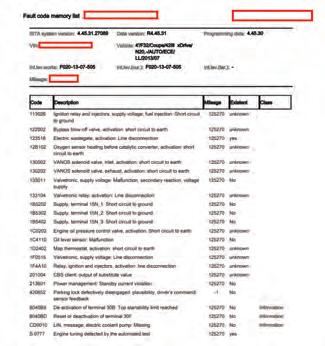
but for their sheer, unadulterated clarity. Yes, amidst the chaos, there are beacons of light and for those of us who fancy ourselves as automotive Sherlock Holmes, these highlighted images are our Dr. Watsons.
Now, let’s cast aside the usual headache of trying to wrestle every single fault code to the ground and focus on the most important ones. Glancing at fault code 113026, we're not just looking at a short to ground – oh no, we're staring into the abyss of an electrical Armageddon, a short so bold it might as well have its own theme music. And then, as if to add insult to injury, code 1F4A10 waltzes in, casually announcing that the fuel injectors and coil packs power supplies have decided to take a sabbatical.
So here we are, left pondering the existential questions of our time: Why has our trusty set of coil packs ceased to spark? And why oh why have our fuel injectors taken an unexpected leave of absence from their daily grind of atomising fuel into the cylinders of this trusty N20? (Fig.1). We can't help but feel a tingle of excitement – because solving this puzzle is what gets our sprockets turning (Fig.2).
PMM JUNE 2024 15
READ ME TO COLLECT YOUR CPD POINT CPDZONE
the cause
simple
The N20 gets a lot of bad press but if looked after it isn’t so bad
A large number of fault codes yet
is

At the heart of diagnosing this puzzle is understanding the system. Essentially, the injectors and coils have been benched because of an active short. Shorts to ground are notorious for their potential to escalate from a spark to a bonfire. Sensibly, the DME has decided to cut the power to prevent any pyrotechnics. Here’s how it works: the DME grounds the relays in the power distribution module, which in turn energises the relays nestled inside. Once energised, these relays supply 12V to the fuses within the same module. This action makes voltage available to the DME, powering up our coil packs and injectors (Fig.3).
Convinced the culprit lay with a rogue injector or coil, I dove straight in, pulling the coils first. The second coil looked like it had seen better days. In a stroke of luck, leaving this coil disconnected allowed the engine to start on three cylinders. After this, I was able to clear the fault codes (Fig.4).


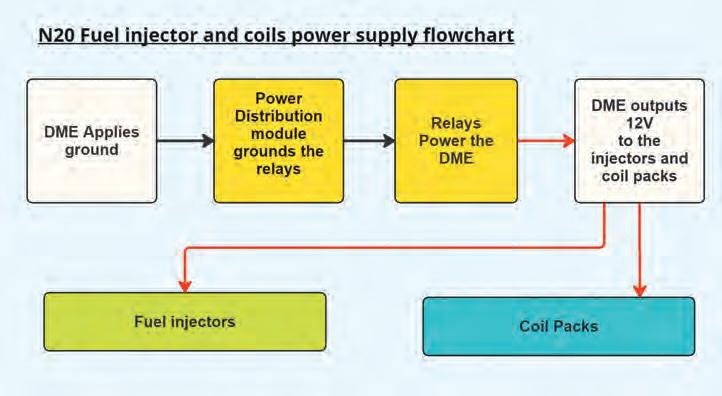
The source of the voltage comes from the power distribution module and sure enough it was as dead as a doornail, zero volts displayed on the red/green wires of the main connector and the trigger wire, a grey jobbie, was showing 12V – a sure sign of a ground switch not grounding (Fig.5). When we see 12V like this it should be understood that it is there as a substitute value, it is there in place of the ground to prevent the ground switching relays in the power distribution box. It may be 12V but it has no potential so to speak (Fig.6).
Armed with the Power Probe Maestro, the next logical step was to scrutinise the ground trigger. Upon testing, it was observed that reintroducing the number 2 coil pack caused
16 JUNE 2024 PMM
READ ME TO COLLECT YOUR CPD POINT CPDZONE
This type of deposit is a classic sign that petrol has been present at some point and has baked on this oily brown colour to the coil.
Disconnecting the number two coil allowed the engine to start.
A power distribution module. Three relays (not visible) sit on the opposite side of the circuit board. The yellow pin is the ground trigger from the DME.
Fuel injector and coil power supply flowchart
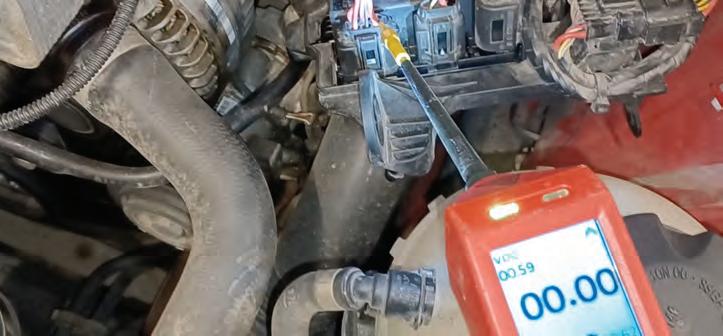

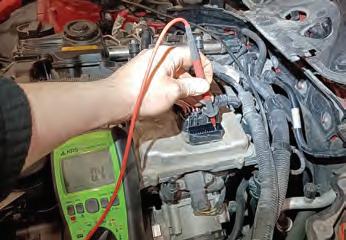
the ground trigger from the DME to switch to 12V (Fig.7). Replacing the coil with a new one didn't rectify the issue, leading to a detailed inspection of the coil pack wiring. Surprisingly, the ground and power supply were intact, but the switched signal wire from the DME exhibited a ground when it was expected to show around 3.7V. This anomaly pinpointed our culprit (Fig.8).
The critical question arose: was the fault due to a short in the wiring harness or a faulty DME transistor? A simple test by disconnecting the wire from the DME pin 13 allowed the car to start, suggesting a closer examination of the DME. Disconnecting the wiring and conducting a continuity check to ground on pin 13 of the DME (coil 2 signal) confirmed the diagnosis: the DME, or more precisely, its transistor, was compromised (Fig.9). The evidence suggested that the malfunction was not due to the wiring but likely caused by the problematic coil pack burning the transistor inside the DME. Usually, this fault would not prevent the car from starting but there is always a first time for everything.
With the diagnosis clear, the decision was made to replace the defective coil and spark plug. Meanwhile, a used DME was sourced and cloned using the Thinktool Euro Master, which facilitated the cloning process to a straightforward plug-and-play operation (Fig.10). This repair strategy brought the 428i
back to life, running smoothly once again. This N20 engine is back in action, purring away without any current threats that might lead to another transistor meltdown in the number 2 coil pack. As is often the case, budget considerations guide many repair decisions. This time, the focus was solely on replacing the offending parts: the number 2 coil and, as a precaution, its spark plug. Ideally, a full set of four coils and plugs would be the recommendation for a comprehensive fix, yet the reality of customer preference and financial constraints led to a more targeted approach, addressing only the directly affected components.
The journey of automotive fault finding is as much about learning and applying knowledge as it is about the satisfaction of resolving issues. Each success builds more confidence and expertise. And remember, for more insights into fault finding and to see these principles in action, don't forget to check out my YouTube channel for further fault finding insights. Here's to continually expanding our horizons, applying what we've learned, and celebrating every victory along the way. Until next time, keep nurturing your skills and enjoy the journey.
WANT TO KNOW MORE? FOR MORE INFORMATION
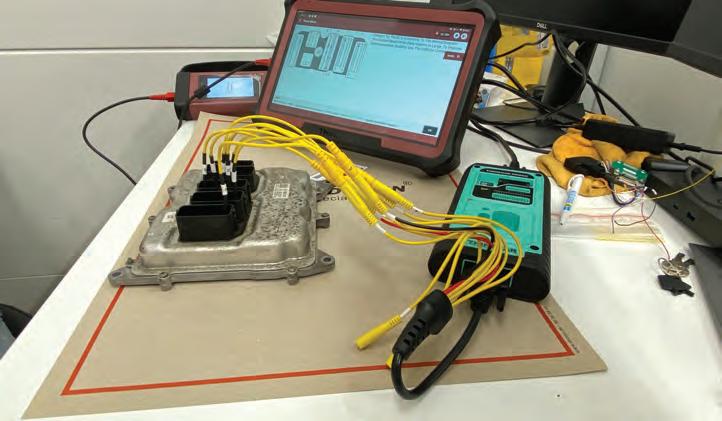
PMM JUNE 2024 17
WWW.RDR.LINK/ABJ001
No ground at the ground trigger point at the DME with number two coil connected.
Very handy when you can clone a used DME in house.
A DME coil pack transistor shouldn’t have continuity to ground. This one did which meant a repair was needed.
Voltage missing at the power distribution module. This car will never start in this state.



REGISTER FOR FREE AT WWW.MECHANEX.INFO THE HANDS-ON TRADESHOW FOR INDEPENDENT WORKSHOPS TOP AUTOMOTIVE BRANDS ● LATEST PRODUCTS AND INNOVATIONS ● SPECIAL SHOW DISCOUNTS ● FREE CPD TECHNICAL SEMINARS ● FREE ENTRY ● FREE PARKING ● FREE PROFESSIONAL MOTOR MECHANIC T-SHIRT ● FREE BACON ROLL The regional Tradeshow for aUTo rePair Professionals PROFESSIONAL MOTOR MECHANIC MECHANEX FEATURING LIVE YORKSHIRE EVENT CENTRE HARROGATE YORKSHIRE EVENT CENTRE HARROGATE 15TH & 16TH MAY 2025 SANDOWN PARK SURREY SANDOWN PARK SURREY 12TH & 13TH NOVEMBER 2024
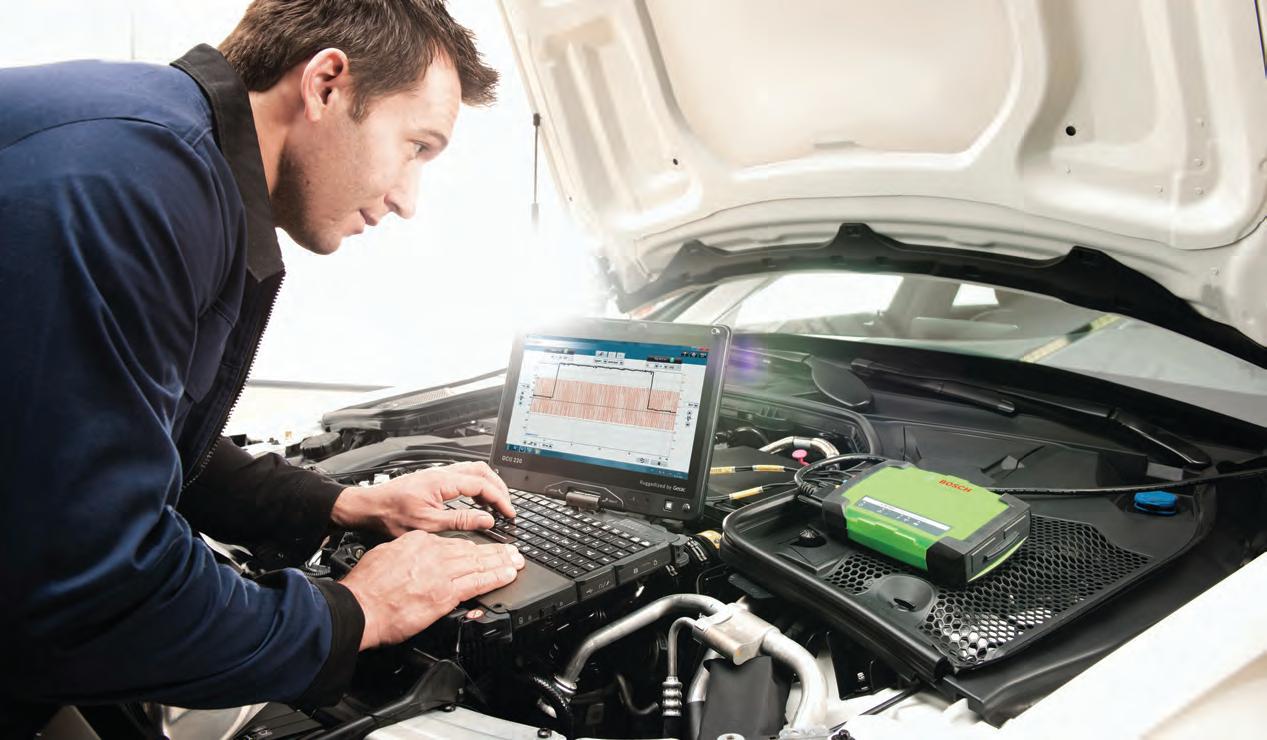
DIAGNOSTIC GUIDE
Using Bosch’s ESI[tronic] 2.0 software: a monthly guide
Last month in our guide to Bosch’s KTS diagnostics software, ESI[tronic] 2.0, we looked at the diagnosis tab and mastering actuator tests. This month, we’re testing out the built-in multi-meter and oscilloscope.
In the tenth article in our series, we’re going to introduce you to the added benefit of vehicle diagnosis with the built-in multi-meter or oscilloscope functions included in the KTS vehicle communication interface.
Alongside all of the other equipment required to effectively work on modern cars today, many technicians consider a graphing multi-meter or oscilloscope a luxury investment. The good news is, if you own a Bosch KTS 560, a single channel multi-
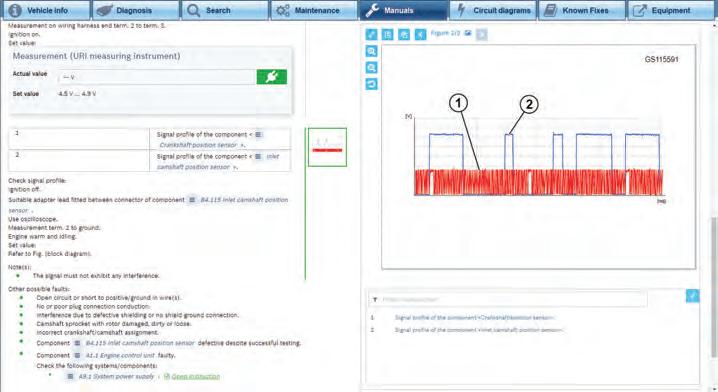
meter is included. While Bosch’s flagship tool – the KTS 590 – features a two channel multi-meter or oscilloscope which is all ready for you to use (Fig.1). The kit contains high-quality colour-coded test cables and probes, which use standard 4mm ‘banana’ type connectors.
First time fix rate
As we all know, a diagnostic trouble code (DTC) will often only give guidance to the general area of a system that is suspected to be faulty or out of range. Once a DTC is read from the error memory of a control unit, a robust fault-finding process is required to test the suspected component and its associated electrical circuit. In Bosch ESI[tronic] 2.0, there are many service information system repair instructions linked to an error memory code that will suggest a direct measurement needs to be made of the voltage supply, earth path, signal/command wire or component resistance in the system (Fig.2).
Your path to diag success!
PMM JUNE 2024 19 READ ME TO COLLECT YOUR CPD POINT CPDZONE
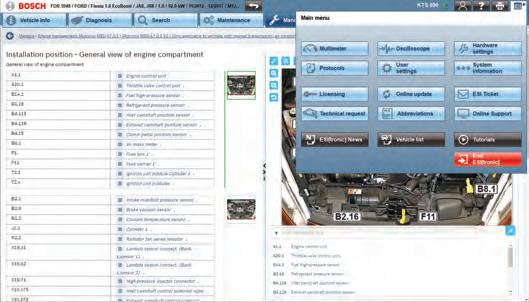
These values can be tested using the Bosch KTS multi-meter or oscilloscope, along with ‘guided’ fault-finding instructions and technical data. This added confidence in your results can lead to a dramatically improved first time fix rate.
For this article, we’ll concentrate on the multi-meter and oscilloscope functions of the KTS 590. Remember that if you have a KTS 560, there is no scope capability built into the VCI. For technicians that use a separate oscilloscope – such as the Bosch FSA 500 or FSA 720/740 series – then the KTS 560 is perfectly suitable for multi-meter use.
KTS multi-meter functions
To get started, let’s take a look at the Bosch KTS multi-meter functions that can be used alongside the ESI[tronic] 2.0 vehicle diagnostic program. When the multi-meter is accessed via the main menu (Fig.3) a new window will appear on-screen with the multi-meter display and measurement selection options. Now you can overlay the multi-meter results screen over ESI 2.0 and see the serial diagnostic data and direct measurements side-by-side (Fig.4).
The test results will be wirelessly displayed on your PC screen, with the measurements taken by the probes attached to the KTS VCI connected to the vehicle. The readings can be shown in a numerical form, with a useful bar graph, or in a graphing trace format, with up to a minute shown across the screen for added convenience.
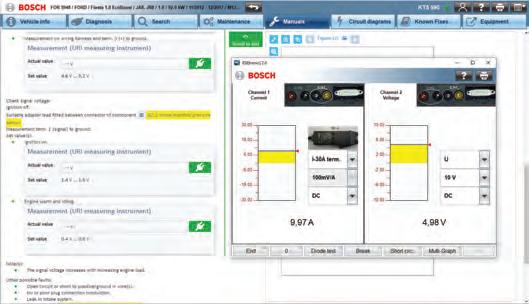
Another great feature is that, just like the actual value time profile display in ESI[tronic] 2.0, the multi-meter graph can be paused, reviewed, saved and printed (if necessary) for reference (Fig.5) – also showing battery voltage and current upon starting the engine.
For voltage and current readings, we have the choice of DC, AC or EFF (root mean square) settings on both channels and resistance measuring up to 1 MΩ on channel onw. You can connect a Bosch amps clamp
“Using an oscilloscope opens up a whole new dimension of system diagnosis by presenting you with a representation of voltage over time.”
with adapter for non-intrusive current measurements to be displayed on screen. A really useful additional feature of the KTS multi-meter is the circuit break and short circuit function, which you can configure to emit an audible warning signal when you conduct a wiggle test on the suspect harness to help you find wiring faults along a loom.
KTS Oscilloscope
The Bosch KTS 590 two channel oscilloscope functions can be used for even greater in-depth testing of electrical systems
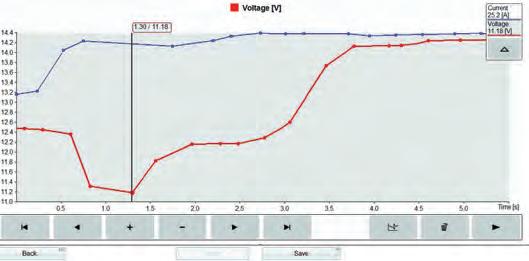
and components. The beauty of using an oscilloscope is that it opens up a whole new dimension of system diagnosis by presenting you with an accurate graphical representation of voltage over time. This means you can see in detail what is actually happening in an electrical circuit in real time.
Fig.6 shows a PD injector and crankshaft sensor signal. Opened from the main menu, the oscilloscope screen can be viewed alongside the ESI 2.0 program and offers many customisable settings that enable you to effectively capture and display the test results you need.
Trigger points can also be set to ensure that signal recording starts where you want it to, while waveform display options can be used to get the best results. There are too many options to describe them all here, but if you hover your cursor over any icon or soft key a ‘tool tip’ pops up with a description (Fig.7).
The time base for both channels can be set between five microseconds and one second across the screen. The safe continuous input voltage to the VCI is a maximum of 60V and the scale of measurement in voltage can display from 200mV (20mV/division) up to 200V (20V/div). The amps scale can also be selected between 30A and 1,000A in the current measurement. If you pause the oscilloscope recording the buffer memory holds the previous 25 screen captures, which can be scrolled through and reviewed – an essential feature if you’re searching for an intermittent fault.
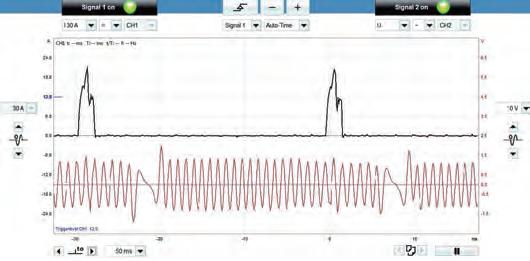
20 JUNE 2024 PMM
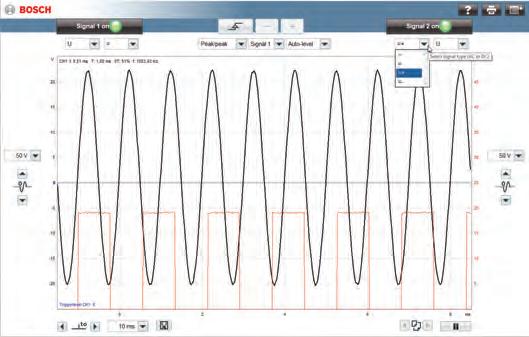
If you only want a single channel measurement, then the blue and yellow cables can be used for potential free testing when the black earth cable is connected to channel two. This set-up can be particularly useful for testing both signal wires of an inductive speed sensor, for example. When a signal is being collected, the ESI 2.0 oscilloscope software automatically starts to calculate the specific signal on/off times as well as the frequency of the waveform if it is a repeated signal such as a pulse width modulated (PWM) duty cycle. This is really useful if you are checking the command

“Another benefit of the oscilloscope is the ability to choose the channel option for signal acquisition”
signal to a component, such as a radiator fan control module.
Another benefit of the oscilloscope is the ability to choose the channel option for signal acquisition via the coloured test cables connected to the channel inputs of the VCI. Additionally, you can switch to the ‘PIN’ input option, where the signal will be taken from the communication pins of the 16 pin OBD socket that will already be connected to the car. The earth pins 4 and 5 and power supply pin 16 are not available to scope this way, but any of the other pins are (depending on the vehicle configuration).
For example, a single wire ‘K’ line on pin 7 or a CAN Bus signal on the traditional pins of 3 & 11 or 6 & 14 could be ‘internally’ tested (Fig.8). This can be a very quick and easy way to investigate if any control unit communication problems occur.
Next month we will look at the maintenance and equipment tabs.
COMMON FAULTS
Why was the Citroen C4’s oil leaking?
Autodata clears up an issue a garage is having with a Citroen C4 Grand Picasso II (2015) whose engine oil leaking from the bell housing area.
The problem:
A customer of ours has a 2015 Citroen C4 Grand Picasso 1.2 petrol. The vehicle had an engine oil leak in the area of the transmission bell housing. We replaced the crankshaft rear oil seal with an aftermarket item. Now the vehicle has come back to the workshop with the same engine oil leak after only a few months. We suspect the crankshaft rear oil seal, are you aware of any other possible causes before we remove the transmission again?
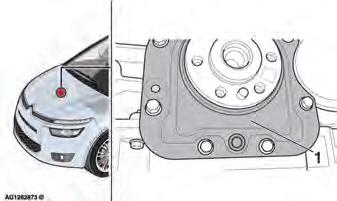
What does Autodata recommend?
Yes, we have come across this engine oil leak issue before. It affects all C4 Grand Picasso models with HNY engine code and manual transmission produced up to 24/09/15 (RPO 14199). The fault is due to an unsatisfactory design of the crankshaft rear oil seal carrier allowing engine oil to seep out into the transmission bell housing area. To rectify this fault, fit a modified crankshaft rear oil seal carrier complete with new crankshaft rear oil seal, available from Citroen parts department. Inspect clutch assembly for oil contamination, replace if necessary. Carry out road test to confirm the fault has been rectified.
PMM JUNE 2024 21
WANT TO KNOW MORE?FOR MORE INFORMATION WWW.RDR.LINK/ABJ003 WANT TO KNOW MORE? FOR MORE INFORMATION WWW.RDR.LINK/ABJ002
BEST PRACTICE
Battery testing and replacement on electr ic vehicles
Automotive battery specialist Varta outlines the important role traditional 12V batteries continue to play as the vehicle car parc transitions towards an electric future.
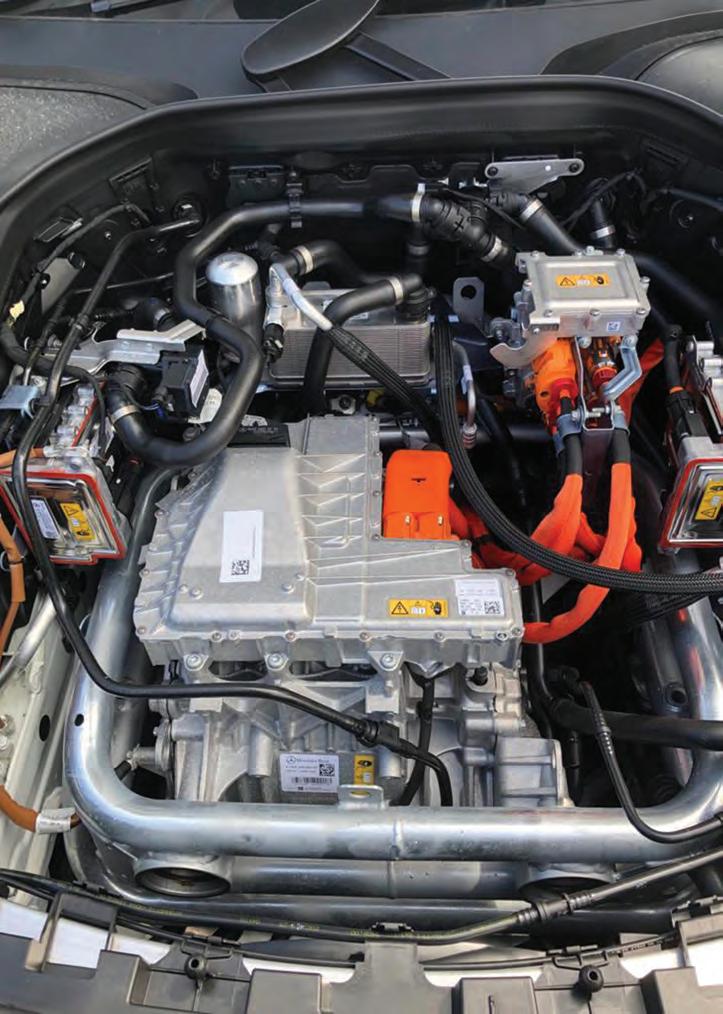
Did you know, as well as startstop and ICE vehicles, nearly all xEVs (BEV, PHEV, FCEV, hybrids) require a 12 volt power supply? As cars become more electrified and autonomous, the traditional 12 volt lead-acid battery is taking on a new and challenging responsibility as a critical source of power across the evolving range of xEVs.
There are an increasing number of electrified vehicles entering the market to support governmental targets of reducing CO2 emissions. Their emergence has intensified low-voltage power demands and is continually redefining the role of the 12V battery. Enhanced levels of vehicle electrification have driven the 12V battery to become a safety critical component, particularly if the high voltage battery fails.
Staying safe
An electric car’s high-voltage li-ion battery powers the drivetrain and the propulsion system, however not the whole vehicle, and not all of its electrical power devices. The internal electrical 12V power system with its comfort and critical safety features, is powered by a 12 volt battery. It works as a secondary power source for the vehicle’s electrical system and ensures that the car maintains its functionality while driving but also whilst parked and the high-voltage battery is disconnected from the drivetrain.
Comfort and safety features like lane assist, power steering and the brake booster are handled by onboard smart systems which also draw power from the 12V system. The same goes for most of the car's monitoring functions, it is therefore essential that a reliable 12 volt power supply is in good working order.
22 JUNE 2024 PMM READ ME TO COLLECT YOUR CPD POINT CPDZONE
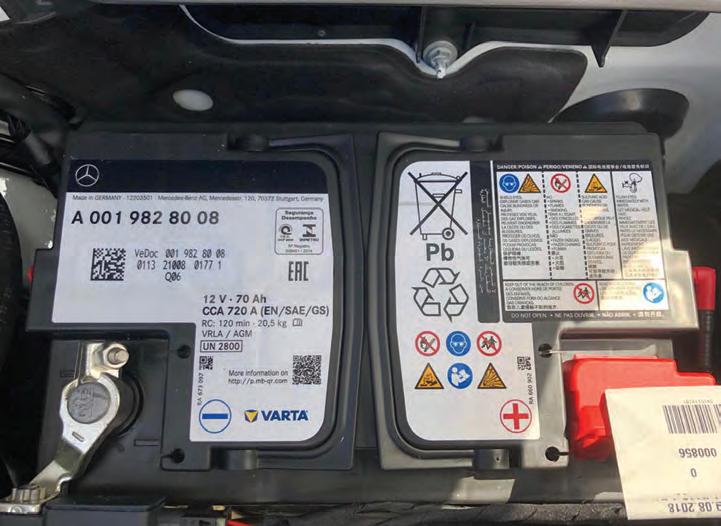
Why is lead-acid technology still being used in a modern electric vehicle?
Lithium-ion technology is often considered the successor of lead-acid technology when it comes to batteries. However, it is not as inherently robust as other battery technologies and requires continuous monitoring by the battery management system. Overall, it is a very sophisticated technology.
Lead-acid batteries, on the other hand, are known to be both reliable and affordable. Their wide operational temperature window intrinsically enhances the operational robustness of the entire system. The safety record of lead-acid batteries makes them invaluable for Europe’s future low-emission mobility sector, plus lifecycle analysis of a vehicle’s environmental impact show that lead-acid has a lower impact compared to other technologies.
In the workshop
As with any 12 volt battery, there is a finite lifespan and once used, a replacement should be fitted. Varta always recommend testing the 12 volt battery of any vehicle when it enters your garage workshop, the same applies to any type of xEV.
When it comes to testing on an xEV:
n The battery cables for the high voltage battery are all orange in colour – do not touch these.
n The 12 volt battery cables are standard and the same as ICE cars in size and colours.
n The 12 volt battery testing method is the same as a standard ICE vehicle, however on full hybrid and BEV cars, the alternator and starting tests cannot be carried out as there is no starter motor or alternator fitted. Charging is completed via the inverter/converter, and starting is achieved using a motor generator in the gearbox.
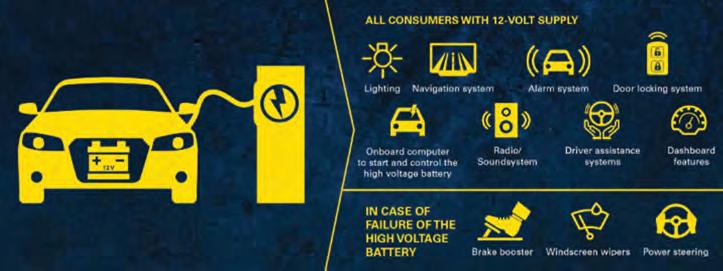
n Ensure the battery tester you are using is capable of reading results from AGM (absorbent glass mat) and EFB (Enhanced flooded batteries), as well as traditional flooded batteries (sometimes referred to as SLI).
Replacement process on xEVs:
n Ensure the vehicle ignition is completely switched off.
n Remove the key and place it at least two metres away from the vehicle to prevent accidental ignition power up, of the smart entry/start system.
n Use the partner portal to identify the vehicle and the location on board of the 12 volt battery.
n Disconnect the 12v battery as per manufacturers’ instructions (there may be a high voltage ‘power-down’ waiting period).
n When the 12 volt battery is disconnected, the high voltage side of the vehicle is also powered down and cannot be powered up again until the 12 volt battery is installed.
n The installation process is the reverse of the removal, the partner portal will be able to advise if recoding of systems or components is required.
The OEMs’ choice
Varta AGM batteries have proven their reliability for many years. It is their sturdy construction, behavior and inherent safety that makes them the perfect companion in supporting the 12 volt electrical system of xEVs. The Varta 12 volt battery portfolio is engineered to support both today's and future electric vehicles.
Being the leading expert in battery solutions, Clarios has its Varta silver dynamic AGM portfolio ready for xEV, now with added designation to the AGM labelling. Designed and tested together with leading car manufacturers, the AGM portfolio for xEV is here to prepare you for servicing the future of mobility.
PMM JUNE 2024 23 WANT TO KNOW MORE? FOR MORE INFORMATION WWW.RDR.LIN K/ABJ004

KNOW YOUR PARTS Ca bin air filtration
Mann+Hummel explores the role cabin air filters play in improving drivers and passengers’ health.
Millions of people around the world are suffering from the effects of polluted air, not only outdoors in spaces with a lot of traffic, but also inside vehicles. It is therefore becoming essential to improve air quality by reducing particulate matter and harmful gasses. With its latest innovation in cabin air filtration, global filtration expert Mann+Hummel is concentrating on a particle size that is becoming increasingly important – so-called ultra-fine particles (less than 0.1 micrometer). These can get particularly deep into the human body and cause harmful damage. The World Health Organization is also paying particular attention to ultra-fine particles and in its latestair quality guideline has called for this particle size to be included in routine measurements.
Regardless of the drive system, cabin air filters play a major role in providing drivers and occupants with clean and healthy air. In electric vehicles, there is also a trend toward improving air quality through multi-stage filter systems.

Are multi-stage HEPA filter systems the future?
Mann+Hummel has developed HEPA filter systems to effectively protect people from these microscopic impurities. The abbreviation HEPA stands for high wfficiency particulate air. It is not a protected term, so special care must be taken here. The addition of “in accordance with DIN EN 1822 and ISO 29463” indicates whether a filter actually meets the high requirements of European and international standards. “Our filter media meet these requirements,” explains Christiane Michel, business development manager at Mann+Hummel.
“Our multi-stage cabin air filter systems with highly efficient HEPA filters offer protection through clean room quality air filtration, as is also the case in operating rooms, for example. Depending on the HEPA class, at least 99.95 per cent of the particles are reliably removed from the air, including harmful bacteria, viruses and other microorganisms, even the previously mentioned ultra-fine particles. These are so small that they can easily penetrate into the bloodstream, cause severe damage to organs and be carcinogenic,” Michel adds. “We now know that more than 90 per cent of the particles in the air are ultra-fine particles. Whether they are safe or not depends on their source and chemical composition.”
PMM JUNE 2024 25
READ ME TO COLLECT YOUR CPD POINT CPDZONE
Mann+Hummel uses the HEPA filter as part of a three-stage system along with a prefilter and a cabin air filter. Both can be equipped either as pure particle filters, in combination with activated carbon or as a third version with biofunctional and microbial coating. The particle filter uses a special nonwoven material that efficiently retains dust, soot and pollen, while the activated carbon filter adsorbs harmful gasses and odours. A biofunctional coating binds allergens that can be released from pollen and provides additional protection against the growth of mould and bacteria on the filter medium.
HEPA filter properties
Michel describes the situation: “Since a HEPA filter can capture much finer particles than a conventional cabin air filter, its fibre structure is significantly denser, which results in significantly lower air permeability. To compensate for this, a HEPA filter has more media surface area and thus achieves the lowest possible pressure drop. In fact, the surface area of the filter media in our HEPA filters is about five times larger than in a conventional element, thanks to a smaller pleat spacing. It is therefore currently not possible to replace a standard cabin air filter with a HEPA element. Air conditioning systems are not built for these high efficiency filters. Instead, the HEPA filter is located in a separate system – usually outside the air conditioning system – together with a prefilter, as protection for the HEPA filter."
Smart multi-stage HEPA filter systems are also designed to ensure that filtration only takes place when it is needed. An intelligent control system records the air quality and provides data on the basis of which the system decides which of the three filters the air should flow through. "This ensures that the HEPA filter is activated automatically as the final filtration stage only when required, for example, when the outside air is heavily contaminated. This allows the size of the system to be kept small and extends the life of the HEPA filter," according to Michel.

“In fact, the surface area of the filter media in our HEPA filters is about five times larger than in a conventional element, thanks to a smaller pleat spacing.”
Christiane Michel, Mann+Hummel
Reducing particulate matter
Another future filtration solution from Mann+Hummel for the independent aftermarket is the reduction of particulate matter generated in road traffic. These particulate emissions include not only exhaust gasses, but also particles that enter the air as a result of braking and the wear of tires and road surfaces. The problem of particulate matter is therefore independent of the drive system and also applies to electric vehicles. To prevent this particulate matter from entering the atmosphere in the first place, the experts at Mann+Hummel take care of these particles as soon as they are created. They have developed a wide range of solutions to improve the particulate matter balance of vehicles. In addition to a brake dust particle filter that reduces brake dust emissions
directly at the source, there is also a filter for the roof or underside of vehicles that collects particulate matter from the ambient air.
Cabin air filters will remain an essential component of future vehicles – regardless of the drive system. Up to 540,000 litres of air per hour can flow into a vehicle via the ventilator. In this way, pollutants can enter the vehicle interior from the outside and remain there for a long time – increasing the air pollution in the vehicle interior. This is precisely where multi-stage cabin air filter systems with their advantages come into play, but also effective cabin air filters such as the Mann-Filter FreciousPlus with its biofunctional coating and effective protection against allergens, harmful gasses and particulate matter. In order for a cabin air filter to function properly, it is important to replace it regularly. The recommended replacement interval is 12,000 miles or once a year.
“Our goal for the future is to offer further cutting-edge technologies inside the vehicle, such as digitally displaying the filter status and air quality in real time,” concludes Michel.
26 JUNE 2024 PMM READ ME TO COLLECT YOUR CPD POINT CPDZONE WANT TO KNOW MORE? FOR MORE INFORMATION WWW.RDR.LIN K/ABJ005


Replace the dual mass flywheel on an Audi A4 with Multitronic clutch HOW TO
In this month’s Schaeffler LuK clutch feature, REPXPERT Alistair Mason is looking at something a bit different, it is an Audi A4 2.0 TDI that has covered just over 114,000 miles fitted with a CVT Multitronic gearbox. The customer has reported that they can hear a rattling noise and would like it investigated.
VEHICLE INFORMATION
Manufacturer: Audi
Model: A4
Engine: 2.0 TDI
Mileage: 114,000
Schedule time: 7.7 hours

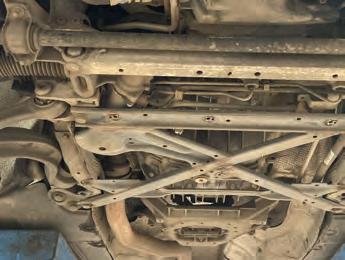
n The lockingwheel bolt key from thecustomer
Gearbox removal
With the vehicle placed in the lift remove the ignition key and ensure the steering lock has activated, open the boot, remove the spare wheel and disconnect the battery lead, open the bonnet and raise the vehicle to waist height, remove both front wheels and plastic drive shaft shields, this now gives us access to the driveshaft flange bolts which can now be removed and also the N/S driveshaft shield (Fig.1). Raise the vehicle lift to gain access to the underside, remove the engine and gearbox undertrays, disconnect the metal power steering pipe from the O/S subframe, remove the floor brace bars (Fig.2), disconnect the steering column universal joint from the steering rack, remove the anti-roll bar to subframe clamps, move the anti-roll bar down and then remove the two bolts that secure the steering rack (Fig.3) and then ease the steering rack down, this now gives access to the two starter motor bolts that can now be removed. Remove the two subframe heat shields that are located by each driveshaft as this gives us a little more space, remove the front engine mounting, slacken the exhaust centre sleeve and slide back to disconnect the exhaust and also remove the exhaust front pipe bracket (Fig.4).
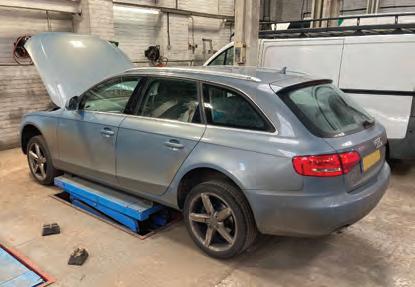


READ ME TO COLLECT YOUR CPD POINT CPDZONE 28 JUNE 2024 PMM

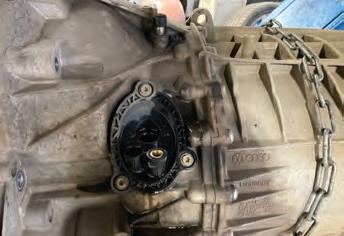
Support the gearbox with a transmission jack and remove the gearbox mounting assembly, lower the gearbox slightly, disconnect the large multiplug on the back of the gearbox and remove the gear change cable, then with a long extension the upper bellhousing bolt can be removed, place an oil drainer under the gearbox and disconnect the oil pipes that go into the top of the gearbox on the O/S (Fig.5), clamp the two oil pipes in front of the anti-roll bar on the N/S, disconnect and cap if possible to prevent leakage (Fig.6). Remove the plastic plate at the bottom of the bellhousing and remove the three bolts that secure the DMF to the engine drive plate (Fig.7), to rotate the engine, remove the rubber grommet from the bottom pulley, using a socket and bar, rotate the engine in 120° intervals to gain access to the bolts. Now remove the rest of the bellhousing bolts, using a second transmission jack or support, support the front of the engine, now ease the gearbox back and when it is clear of the engine carefully lower the transmission jack, keep an eye on the steering rack and cooler pipes as the gearbox is being lowered, when fully clear wheel the transmission jack clear of the vehicle.
DMF replacement
We now need to remove the driveshaft from the gearbox, rotate the gearbox so that the differential is closer to the floor, this will prevent oil leaking out of the differential when the driveshaft is removed. Remove the three bolts from the plate that retains the driveshaft (Fig.8) and the ease the driveshaft out of the gearbox. The DMF can then be lifted off the clutch input shaft and removed from the gearbox, clean the bellhousing area, inspect the clutch input shaft for any wear. If all is ok, apply a light smear of high




melting point grease to the splines of the clutch input shaft.
If we turn are attention to the removed DMF (Fig.9), unfortunately there is no way these can be tested in the workshop, all we can do is carry out a visual inspection and

feel the rotation of the secondary mass, this flywheel did not feel smooth in operation when compared to the new one.
Now mount the new DMF onto the clutch input shaft with the aid of the handle provided in the DMF kit and support with the special tool also provided (Fig.10), the driveshaft can now be carefully inserted back into the gearbox and secured with the three bolts.
Gearbox installation
Level the gearbox on the transmission jack ready for installation, check all cables etc. are clear of the back of the engine and that the engine to gearbox alignment dowels are installed correctly.
Carefully ease the gearbox into position, when the gearbox is located on the alignment dowels, push the gearbox so it is fully against the engine, install a couple of easily accessible bellhousing bolts and tighten. Installation is then in reverse order of removal. Remember to:
■ Top up the gearbox oil
■ After connecting the battery, reset all effected electrical consumers
■ Always carry out an extended road test to ensure a quality repair
REDEEM YOUR CPD CREDIT
Congratulations, you have reached the end of the CPD Zone! To access your CPD credit from The CPD Group, scan the QR Code or WWW.RDR.LINK/ABJ006

PMM JUNE 2024 29
Laser Tools Racing with MB Motorsport launch celebratory tenth-anniversary livery

This issue, we look back to just before this year’s season start when Laser Tools Racing with MB Motorsport revealed the team’s striking new livery for the 2024 Kwik Fit British Touring Car Championship campaign. This year’s iteration of the affectionately named ‘Laser Beamer’ is a particularly special one for the team as Laser Tools Racing celebrates their tenth campaign in the UK’s premier motorsport series. With this in mind, the team’s BMW 330e M Sport features the iconic Laser Tools Racing chrome blue with the livery designed to feature ten chevrons from every angle of the car.
Once again, the team’s on-track efforts are being spearheaded by fan favourite, Jake Hill. Having finished third in the Drivers’ Championship in 2022 and 2023, the Kentbased driver is looking to challenge once again for overall honours and is delighted to be doing so in a special livery for him and the team.
Jake commented at the livery launch: “It is fantastic to see the covers come off our 2024 challenger today and I have to say, although I loved the Laser Beamer last year, I think we have managed to top it once again this time around. The chrome blue has been iconic across the series for so long so it’s only right we have levelled this up in 2024 as Laser Tools Racing celebrates its tenth anniversary in the championship.”

Laser Tools Racing’s Motorsport Sponsorship Coordinator, Keith Anderson, has played a pivotal role in the team’s decade in the BTCC and the launching of their ten-year anniversary car marks a proud moment for the organisation. “I’m not quite sure where the time has gone,” said Keith, “but it is fantastic to mark a decade of success for Laser Tools Racing in the BTCC with the launch of our 2024 challenger. We cannot wait to see Jake leading from the front in the second iteration of the Laser Beamer!”
Laser Tools Racing also revealed the livery that Nelson King will run for his second season in the Vertu MINI CHALLENGE season. King joined forces with Laser Tools mid-way through his rookie campaign and he looks to improve on the top-three championship finish he secured last year. The Mini is running a special celebration livery similar to that seen on the BTCC BMW. Nelson is also very enthusiastic: “I’m incredibly excited to be teaming up with Laser Tools Racing for a full season, especially during their tenth anniversary. I believe that together, we can achieve phenomenal results this year.”
CONNECTIONS QUIZ
Try and figure out what connects each of the answers!
1. Which book won John Steinbeck the National Book Award and the Pulitzer Prize?
2. Which British girl group covered “Venus” in 1986, reaching number one in six countries?
3. What awards are given out to the worst films in “competition” with the Oscars?
4. Which global company was founded by Steve Jobs in 1976?
5. James Franco and Seth Rogan starred in which film together in 2008?
6. Which Harry Styles song features the lyrics “Tastes like strawberries, on a summer evening.”
7. Complete the phrase “When life gives you _ make _”
8. What are people from New Zealand called?
9. Which English former footballer played as a goalkeeper for Manchester United, Middlesbrough, Liverpool and Hartlepool United in a career spanning 20 years?
10. What connects all the answers?
Answers: 1. The Grapes of Wrath 2. Bananarama 3. The Golden Raspberry 4. Apple 5. Pineapple Express 6. Watermelon Sugar 7. Lemons, lemonade 8. Kiwis 9. Stephen Pears 10. Fruit
TheHRdepartment wouldlikeaword!
Jennifer Webb, owner and director of HR Vitals, has been taking the aftermarket by storm with her tailored advice guiding garages through the personnel pitfalls inherent in running a business. In her new column for PMM, she will be sharing her experiences, her top tips, her thoughts and anything else that will encourage you to take the human resources aspect of your business as seriously as any successful business owner should. In her first column, she paints her impressions of the aftermarket so far.
Hi, I’m Jen. I have been working in the aftermarket since 2018 and from what I can see – that means I am still a newbie in comparison to most, and probably you.
What was my background before? Well, I have worked in quite a mix of places, including a zoo, a hospital, the bank, a rehab centre… I’ve worked in care, in a bar and, finally, in HR. Fast forward to 2024, I have worked with over 200 garage owners and even married one!
So, what are my first impressions? Here are just two that come to mind immediately.
Firstly, people value people. This is my biggest observation. Technicians leave main dealers because they don’t want to feel like a number. The boss is
LIFE IN AN EV GARAGE
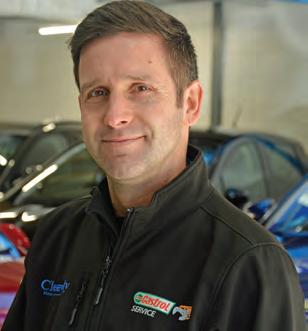



vitally important to how the team thinks about the day. People want to be good workers and to be seen as such. And the employers? Employers want to find good, reasonable, trustworthy and conscientious people. One bad apple can really upset the workplace.
Secondly, you don’t realise how much you value people. You may think my first point is obvious, but from an outsider perspective, you (generally speaking) value the first point
In his third instalment, Matt Cleevely argues garages need to stop burying their heads in the sand when it comes to EVs in the UK.
There are more than one million pure battery electric cars and vans on the road in the UK and, with new regulation requiring vehicle manufacturers to sell an increasing number of EVs each year, there will soon be many more. The sale of all new petrol and diesel cars will be banned in the UK by 2035 as part of the government’s zero emission mandate and under Labour this could be sooner.
This year, VMs must ensure at least 22 per cent of all new cars sold in the UK are zero emission. This figure will rise to 80 per cent by 2030. VMs could be fined up to £15,000 for each non-zero-emission vehicle sold outside of the allowance. What we’ve seen so far – and what we’ll continue to see – is the exponential growth of EVs. The Nissan Leaf has been on our roads for more than ten years now. Look at
more than you give credit to. The bad apple stays for longer than they should, you pray that the good people stay and you like to employ people who you already know. People want to feel involved, they like to know where they stand, they don’t want to feel pushed out or left behind. Humans, after all, are the ones who can make or break the aftermarket.
And these are my top two observations, what do you think? Am I stating the obvious? Does it ring true? Let me know what you think.
what happened during that time and then consider the impact of the zero emission mandate. Like them or not, EVs are here to stay and, for garages prepared to integrate them into their day-to-day workload, they’re bringing an untapped opportunity for growth.
Cleevely EV happened to be the UK’s first independent EV specialist – that’s why we’ve seen the success we have. I’m appealing to other independents to be the first in their county, city or town because there’s plenty of EV work for all of us. I’m not saying close the door on ICE vehicles. Around 55 per cent of the jobs in our workshop are still on ICE. But it’s about preparing now to secure your future, a future in which EVs will play an increasingly important role.
The irony is that even main dealers still aren’t ready to work on EVs in volume either. That's why independent garages have a genuine opportunity to come out on top, capture and retain a new customer base.
FORMOREINFORMATION GO TO WWW.RDR.LINK/ABJ 008 PMM JUNE 2024 31
FOR MORE INFORMATION GO TO WWW.RDR.LINK/ ABJ007
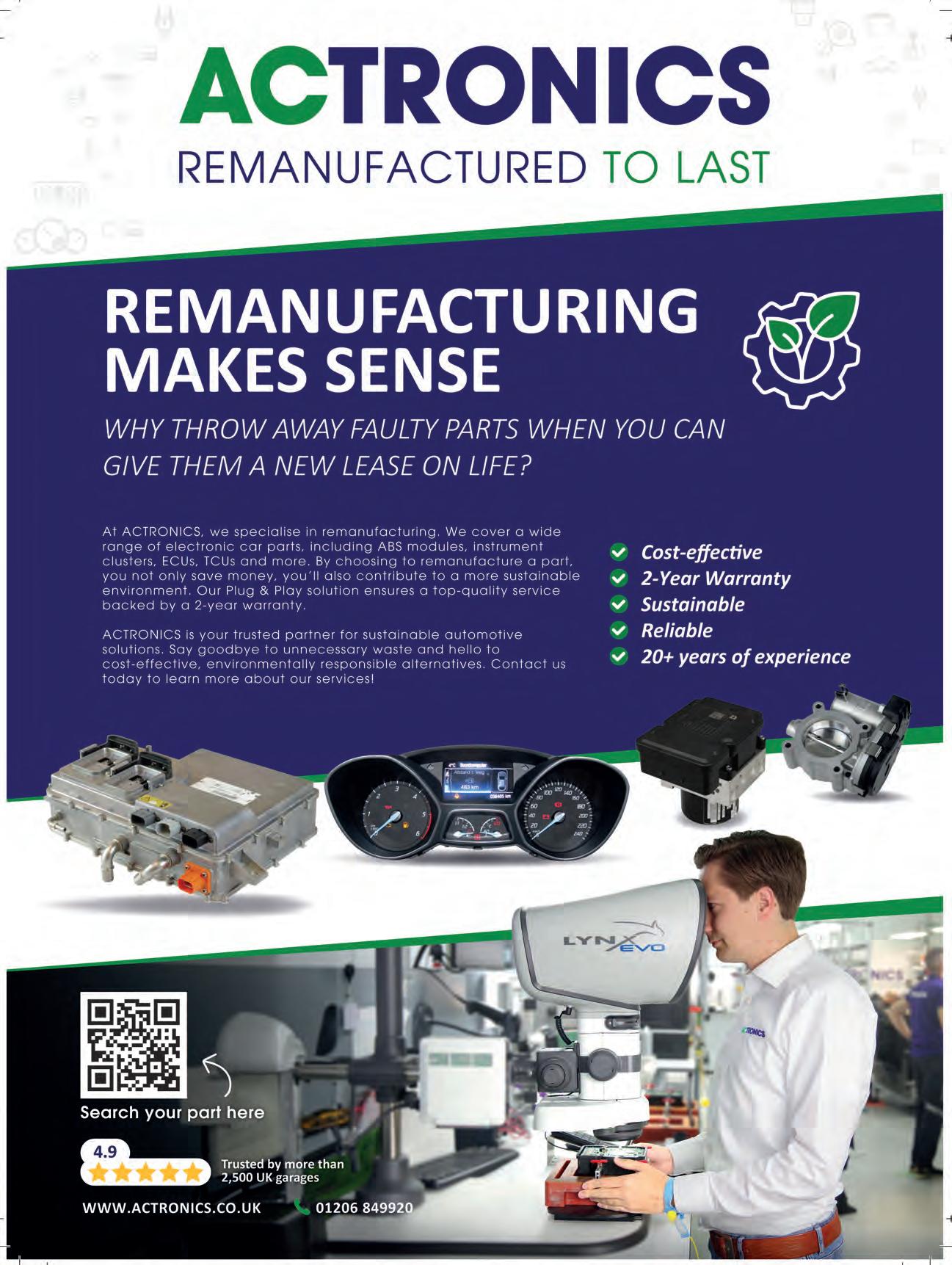
A look inside: YouTube

Your favourite trade magazine is now on YouTube, bringing you reviews and video guides on the best tools and workshop solutions. Find us at @professionalmotormechanic . Recently, we got Ed from Uckfield Motor Services to give us his thoughts on Hickleys’ new Zenith Z5 diagnostic tool.
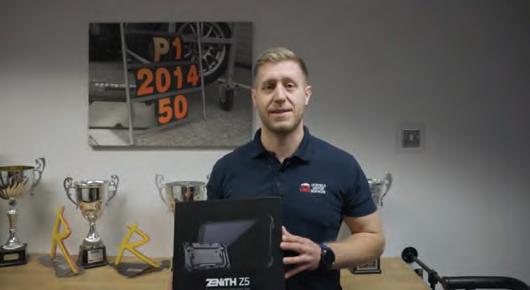
“ First impressions on this is it's rugged. It looks really well thought out and well built. The software on it's based on Android, so the systems are all good. We've got this Mitsubishi L in today. As you probably seen for the previous videos, it's had a front-ender, it's been to the body shop and it's had some repairs done to it. And since that, the car won't start when the headlights are plugged in. So we're going to carry out a complete full code scan and see what we've got in there. Obviously this takes a little bit of time to go through all the various modules, so we'll see what it comes up with in a minute.”


“ So now we've had a good play with the Zenith Z diagnostic tool in the workshop and I'm really happy with it. It fills a gap in my diagnostic computer array. We've got about three or four tools and this fits in really well with what we've already got. The main reason is because it's small, robust and it's just nice to hold and use. Most diagnostic computers we've got are either bulky or laptop-based, so this is really good to use around the workshop and really quick and easy. Obviously it's Android-based so you know it's going to be relatively reliable and really good like that. The handheld bit on the back as well is lovely.”

“ It's carried out a complete full code scan and the good thing about this is you can click on this show diagnostic trouble code button here and it'll bring up all the codes that are present. The main ones we're looking at is the engine switch and internal errors and the PCM of altercation timeout on here. We've had a quick look at it where it's been repaired and basically the headlight has been poorly repaired. So I'm going to have to get it booked back in with one of my diatechs to have a further look into the wiring and hopefully get this problem sorted. Another cool feature we spoke about was the fact that you can record live data while you're driving. We've all been there, we've had to have a passenger to record the live data. So you can now do it with just yourself on this. ”
“ But the main things I love is the service menu. It's got the quick service task that can do DPF regeneration, injector coding, even the ADAS side of things. The ADAS capabilities are really good on it as well, but you can go in a lot more depth and where it's really, really good and where it's fitted in really nicely in our workshop is the Asian stuff. Kia, Hyundai, Toyota, all that sort of stuff that we tend to struggle with in the workshop. This really fills a gap there. Don't get me wrong, it's still really good across all the other European and the British cars but it's that Asian stuff it's really brilliant with.”

TO WATCH THIS VIDEO AND THE OTHERS ON THE PMM YOUTUBE CHANNEL, SIMPLY SCAN THE QR CODE
PMM JUNE 2024 33

Keep it INDEPENDENT
Performing simple tasks on certain vehicles is posing difficult diagnostic issues to garages. Here, managing director at A1 Diagnostic Solutions, Iain Molloy argues its time for independent garages to take back their time and stop losing profit to the main dealers.
The increasing complexity of systems on modern vehicles is something that’s now front of mind for technicians on a day-today basis. Diagnosing fault lights can be time-consuming and frustrating; something that’s exacerbated by the increasing problem of accessing secure gateways. It’s one of the main reasons I think garages are struggling with key-to-key times.
We’re now seeing garages struggle with something as basic as resetting the service light on a VW ID3. It’s crazy to think a garage may feel its only option is to take the vehicle to a main dealer; this can easily add a week or two onto what should be a 5-minute job. It erodes the garage’s profit margin, takes skilled technicians away from the ramps to transport vehicles backwards and forwards, and causes congestion in the workshop space.
Remote diagnostics
It’s imperative that garage owners can access a solution to this that suits their garage and the profile of its work. This solution might not only involve investing in the right diagnostic equipment. With diagnostics, we all know one job can lead to another, so it’s important to build a relationship with a specialist company that can be relied upon as a bolt-on service to work hand-in-hand with the garage; either remotely or in person. The main objective is to be able to access all the expertise required, in the minimum amount of time, whilst keeping the vehicle in one place.
We had a prime example of this recently. Leo Jayawardena at Ansam Autocentre, an independent garage in Croydon, contacted us with a copy of the diagnostic scan carried out on a Peugeot 3008. The customer had reported the lane assist system wasn't working and a warning light on the dash appeared to support this.
From the scan, Adam, our operations director, recognised a B1004:96 fault code which indicated a faulty camera. This was confirmed by checking the OE technical information for this particular digital trouble code (DTC). As nothing can be done to resolve an ‘internal fault’, we advised the only option was to replace the camera.

Once Leo was in receipt of the new camera, he contacted us again to ask if we could provide OE documentation to remove and fit it. Quite rightly, he wanted to ensure he did so correctly and without disturbing any other component. Whilst this isn’t a service we generally provide, we love a challenge and were able to get the document over to him within 15 minutes.
Once fitted, Leo logged on with us via his A1 Remote Diagnostics interface – from 130 miles away. We configured the new camera to the vehicle using the Peugeot OE diagnostic system; something Ansam Autocentre didn't have access to. The whole process was completed on-demand and in just 14 minutes, at which point one of our ADAS-trained technicians arrived in Croydon and calibrated the camera dynamically.
Overall, by using both our A1 remote service and A1 ADAS mobile service in

conjunction with his inhouse diagnostic equipment, Leo’s interaction time with us was just 30-minutes. Compare this to a week or more away at a Peugeot main dealer, and it’s easy to see how this route makes for efficient garages and happy customers.
I estimate the profit margin on the job was increased by around 50 per cent, and by dramatically reducing the key-to-key time, the customer’s invoice was cleared earlier too.
It’s the best way garages have of controlling the diagnostic demands of increasingly complex vehicles. We’re going to see an inevitable surge in these types of issues. It’s only a matter of time before these systems begin to develop internal failures – as all electronic components do – especially those which are in constant use like ADAS systems.
As the car parc’s original tranche of mainstream technically equipped vehicles are now out of warranty, they’re filtering through to independent garages who need a solution to be able to keep the job in-house.
If garages already have the latest generation Autel diagnostics, they can access the ‘Remote Expert’ function on the tool. A1 Remote Diagnostics has carried out more than 1,500 jobs in the last 18 months.
This tells me garages are finding solutions but there’s still a long way to go in helping them to just get on with what they do best –fix vehicles in a time-efficient, profitable, and hassle-free way.
PMM JUNE 2024 35
DIAGNOSTICS & ENGINE MANAGEMENT WANT TO KNOW MORE? FOR MORE INFORMATION WWW.RDR.LIN K/ABJ009
KNOW YOUR PARTS
Belt-in-oil timing dri ve systems
Dayco’s national sales manager Steve Carolan reminds readers of the benefits of belt-in-oil timing drive systems and the replacement opportunity they provide independent workshops.
Although some might question the validity of the concept, preferring the traditional chain drive solution, the fact that many VMs have long since moved to belt driven timing systems and a growing number are adopting the BIO route, means that the replacement process, driven both by the scheduled service interval and by a repair requirement, will be a more frequent workshop activity.
To help ensure the ongoing reliability of these engines, Dayco, as the pioneers of BIO on behalf of VMs such as Ford, PSA and VW, has for some time been highlighting the importance to workshops nationally of carrying out regular maintenance in line with the VMs scheduled service intervals. This is because, apart from the catastrophic consequences that would result from belt failure, belt degradation can also have serious implications to several other components, such as the oil pump and brake system vacuum pump.
BIO is a fantastic solution that helps small and efficient engines to deliver increased levels of power, alongside lower emissions and better fuel economy, primarily because it reduces friction in the drive system by up to 30 per cent. However, to maintain this level of performance and to continue to operate as the manufacturer designed, they need to be serviced regularly and the condition of the belt assessed.
Replacement tips
Naturally, should the belt need to be replaced, as the original equipment supplier for many BIO applications, we have replacement kits in the Dayco aftermarket range and this provides workshops with a genuine revenue opportunity because over the last year, our sales of BIO kits have doubled, which proves there is a growing demand for the parts and means they can directly benefit from the BIO revolution.

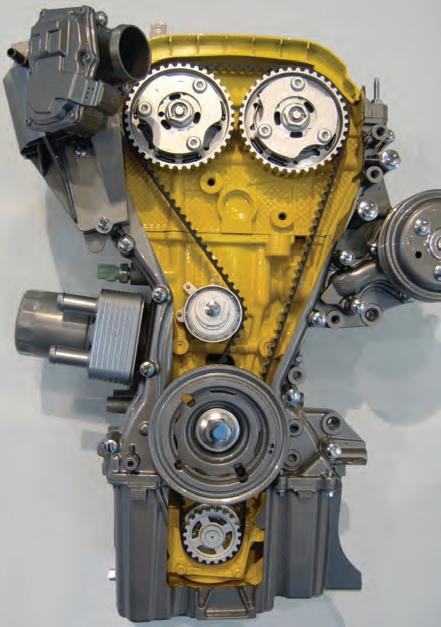
Following developments at the OE level, Dayco has superseded its original replacement kits for the 1.2 petrol engine used in many PSA applications, such as the C-Elysee, C3, DS3 and Expert, and the 1.2 diesel engine for models including C3, C3 Picasso, C4 Cactus, 208, 2008, 308 and 3008, previously KBIO07 and KBIO08, with KBIO14 and KBIO15 respectively.
Alongside the positive revenue generation benefits that the growth in BIO applications provides, Dayco remains active with the workshop, delivering technical messages, ongoing training and general support, all of which helps to promote sales and reduce the risk of returns and unnecessary warranty claims.
Part of this process is to react effectively when problems appear, quickly diagnose why they are occurring and then highlight the issues to workshops and technicians, so they are able to follow the correct fitting procedure to replace them successfully, which will increase customer satisfaction and avoid unnecessary warranty claims back to the factor.
DIAGNOSTICS & ENGINE MANAGEMENT 36 JUNE 2024 PMM

A perfect example is the two-stage tensioning process that must be carried out when replacing the timing belt on the 1.6 and 2.0-litre HDI engines that are widely used by Fiat, Ford, PSA and Vauxhall, in many of their popular models in both passenger car and light commercial vehicle applications. Although the consequences of not following the procedure may not be immediate, because both units are of an interference design, the effect of a subsequent belt failure is likely to be catastrophic to the engine.
Another topical example concerns oval crankshaft sprockets, which also require specific belt tensioning requirements that if not followed, can end up stripping teeth from the timing belt for example. What these examples demonstrate is that even a scheduled service requirement on comparatively common engines requires technicians to follow a specific procedure, not apply a general rule.
EVs incoming
Returning to a subject much discussed within the industry as a whole, but in the aftermarket particularly, it’s worth reminding workshops of the realities of the electric vehicle revolution when it comes to the products that will still be required daily for the foreseeable future. Although the industry needs to be ready and react to a growing demand for EV specific replacement parts, the reality is that the vast majority of the vehicles that will enter the independent workshop for the next decade, will have an internal combustion engine (ICE), whether petrol or diesel.


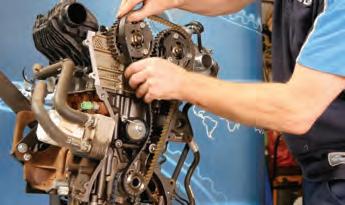
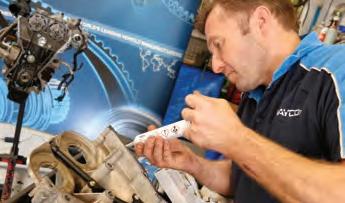
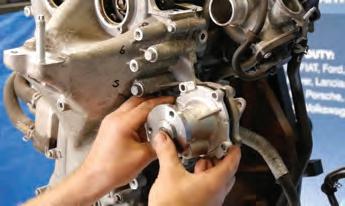
Keeping up with demand
This growing demand for EV parts combined with the reality that ICE vehicles will still be around means that workshops need to keep up to speed with the current technology and be in a position to tackle the immediate needs of motorists and be able to carry out a first rate job first time. This is not to say the industry should be complacent and ignore the upcoming developments in the market and take advantage of the opportunities they present. However, foregoing training and learning more about the best practice service and repair requirements of ICE powered vehicles, which are still becoming ever more complicated, in favour of alternative fuel technology, doesn’t seem a wise decision, while ICE is, and still is likely to be for the next decade, the main revenue source for the typical workshop.
So, picking back up on the subject of BIO, belt and component replacement of these systems will be around for the long term, because even if the move to outlaw the sale of ICE powered vehicles by 2035 does happen, the fact is that the 2.0-litre TDCi engine used in models such as the Ford Transit, is still planned to be in production until 2030, so the newest vehicles are unlikely to enter the aftermarket until 2033.

WANT TO KNOW MORE? FOR MORE INFORMATION WWW.RDR.LIN K/ABJ010

OSCILLOSCOPE DIAGNOSTICS: a guide
There can be no doubt that the automotive service and repair industry has changed beyond all recognition in the last 40 years. The last five years has perhaps seen the largest change, given the exponential growth of electric vehicle sales competing head-tohead with the sale of diesel ICEs. Who could have imagined that statement a few years ago? And who can predict what the next five years in this evolving trade has in store?
With all that being said, one tool has served the motor trade throughout the decades in various forms, with one fundamental principle: to plot signals against time. The tool we fondly refer to as the oscilloscope.
From the late 60s through to the early 80s, oscilloscopes have been used to analyse secondary ignition systems, configure the primary ignition dwell angle and provide a means to qualify ignition timing with combustion quality relevant to mixture content – the process of which was called a “tune up”. The early 80s also saw the meteoric rise of mainstream engine management systems, where the master technicians of the day would comment “cars are becoming too advanced” and “there will be nothing left for us to do now the carburetors and points have gone”.
Roll on to the present day, and similar doom and gloom phrases are flying around again, thanks to the addition of yet another power source in the form of “pure electric”.
I cannot think of a better time to join our profession and embrace the opportunities that lie ahead. The role of the technician is more important now than it has ever been” Steve Smith, Pico
Pico Technology’s technical specialist Steve Smith provides readers of PMM a comprehensive guide to oscilloscope diagnostics.
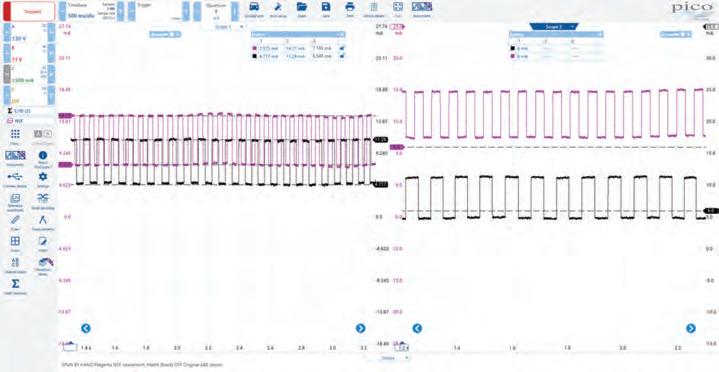
From my perspective, I cannot think of a better time to join our profession and embrace the opportunities that lie ahead. The role of the technician is more important now than it has ever been and continues to advance thanks to new technologies being introduced into the industry.
Make no mistake, regardless of the power source (ICE or electric motor), vehicles will continue to develop faults and require maintenance. These situations will call for a tool that is steadfast and futureproof, a variation on that classic “tune up” machine, the digital sampling oscilloscope.
As our beloved automotive industry has evolved, so has the demand for oscilloscopes that provide a means to capture and correlate analogue and ultra-high speed digital signals, with superior resolution displayed on crystal clear monitors. That device can only be a PicoScope.
A PicoScope is connected to a PC/Laptop via a single USB cable and controlled by the PicoScope 7 automotive software, which is designed and built from the ground up, with ease-of-use in mind. PicoScope lends itself
beautifully to the numerous PC/laptop peripherals at your disposal, in the form of multiple monitors, wireless keyboards, mice, printers, internet access and remote storage.
Whether you are measuring a CAN network, exhaust gas pulsations, vibration via the chassis, or a multi-strike ignition system (all at the same time) you are covered; one might say the PicoScope is the Swiss Army Knife of diagnostics.
After all those sweeping statements, let us focus on several real-life case studies where the PicoScope was used.
ABS warning light illuminated
To cut a long story short, there was no speed signal from the front left wheel speed sensor. The sensor had been replaced with a reputable aftermarket component, along with a wheel bearing containing a magnetic pickup ring. A PicoScope was used to confirm that a speed signal was present at both the sensor and the ABS controller. However, there was still no road speed displayed on the scan tool, accompanied by a relevant fault code for the FL ABS sensor.
PMM JUNE 2024 39
DIAGNOSTICS & ENGINE MANAGEMENT
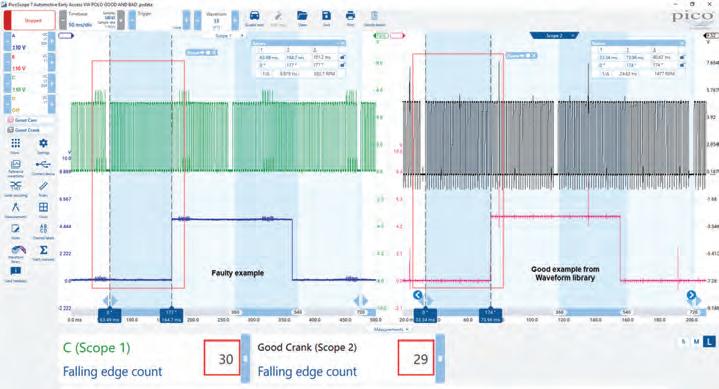
The waveform in Fig.1 was taken from the vehicle’s front left (FL) wheel speed sensor. On the surface, everything looks fine. We can clearly see the speed signal based on the switching current flow through the sensor via a x10 current multiplier. It was only when comparing the current flow through the front right wheel speed sensor that alarm bells started to ring. Once again, everything looks fine on the surface, but a technician with a keen eye would spot that the current flow measurements from each sensor differs!
By using the reference waveform and scaling features in the PicoScope software, we can overlay both the front left wheel speed sensor (magenta) and the front right wheel speed sensor (black) and see the immediate difference.
Focusing on the black signal ruler (horizontal dotted line) of the black waveform in the right-hand image, we have the theoretical crossing point used by the ABS controller to calculate the frequency (approximately 6 mA). Each time the current level rises above 6 mA and then falls below 6 mA, the ABS controller measures the time taken between each of these events and calculates the frequency and, subsequently, the wheel speed. The signal voltage of the magenta waveform never crosses the theoretical crossing point. The current remains above 6 mA, and therefore, the ABS controller simply cannot calculate the frequency; hence no speed signal being recorded via the scan tool for the left front wheel, and the generation of the applicable fault code. Replacing the FL ABS sensor for an OE unit cured the issue.
To see the full case study, WWW.RDR.LINK/ABJ011
Engine management warning light illuminated
A search for diagnostic trouble codes revealed two error codes: P0172 – system too rich and P0106 – manifold pressure implausible signal. After following the relevant flow charts for these codes, with nothing conclusive to indicate the area of the
“By using the reference waveform and scaling features in the PicoScope software, we can overlay both the front left wheel speed sensor (magenta) and the front right wheel speed sensor (black) and see the immediate difference.”
Steve Smith, Pico
fault, we have to think outside the box.
The engine in our scenario utilises a speed/density engine management system. We have to therefore consider events that would cause both implausible manifold pressure and a rich mixture. If the engine cannot breathe correctly, both these DTCs will be stored, therefore a PicoScope would be used to carry out a dynamic valve timing check.
In Fig.2, we have captured our problem vehicle on the left, and compared the cam and crank correlation to a waveform downloaded from a known good vehicle, using the Pico reference waveform library.
Using the tooth count feature (between the time rulers) placed at the rising edge of the crank signal (after the missing tooth) and the first rising edge of the camshaft signal, we have proven our valve timing to be incorrect and hence the cause of our misleading DTCs.
To see the full case study,
WWW.RDR.LINK/ABJ012
A/C communication failure
Given the rise of low to zero-emission vehicles and their accompanying energy efficient ancillaries, here we have a hybrid vehicle utilising a high-voltage motor to drive an air conditioning compressor. The power management control ECU (PMC) reported a communication malfunction (via DTC) with the air conditioning compressor, resulting in the A/C feature being inoperative.
As ever, in order to diagnose a component, we need to know how it works; with our A/C fault we have four wires between the PMC and the AC Compressor. On pin 1 at the compressor
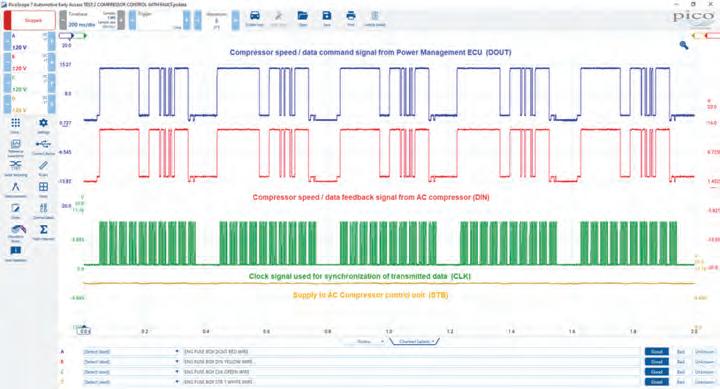
40 JUNE 2024 PMM
DIAGNOSTICS & ENGINE MANAGEMENT
we have a “clock” (synchronisation) signal, pins 2 and 3 have a digital communication signal, and pin 4 has a power supply.
Using the PicoScope, we test all four wires simultaneously and confirm several normal operational characteristics in one single capture (Fig.3).
Referring to the image, we have immediately proved the integrity of our power supply, clock signal and communication lines, so the question is –why is there no communication?
The devil is in the detail, looking at channel A (blue) and channel B (red) above, these are command and feedback signals from the PMC and A/C compressor respectively. Note how they are identical, should they be?
When the PMC sends a command, the response from the A/C compressor would be naturally delayed. The only way in which these signals could be identical is if the communication wires were shorted together. Further testing of the wiring harness confirmed
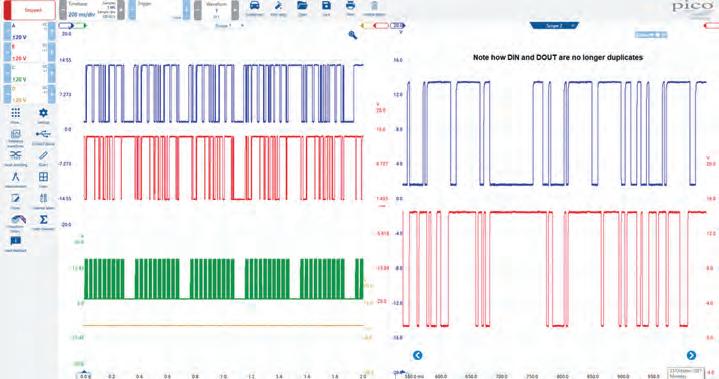
these communication lines had shorted due to recent accident damage “pinching” the loom adjacent to the A/C compressor.
In Fig.4, we have the post-fix communication exchange between the PMC and A/C compressor. What I found interesting about this case study, was the manufacturer DTC flow chart that guides you to the faulty component. At no point are you instructed to test for continuity between the command and
feedback wiring.
As you can see, we have come a long way from the 60s but plotting signals against time still rules the waves when it comes to diagnostics.

WANT TO KNOW MORE? FOR MORE INFORMATION WWW.RDR.LINK/ABJ013
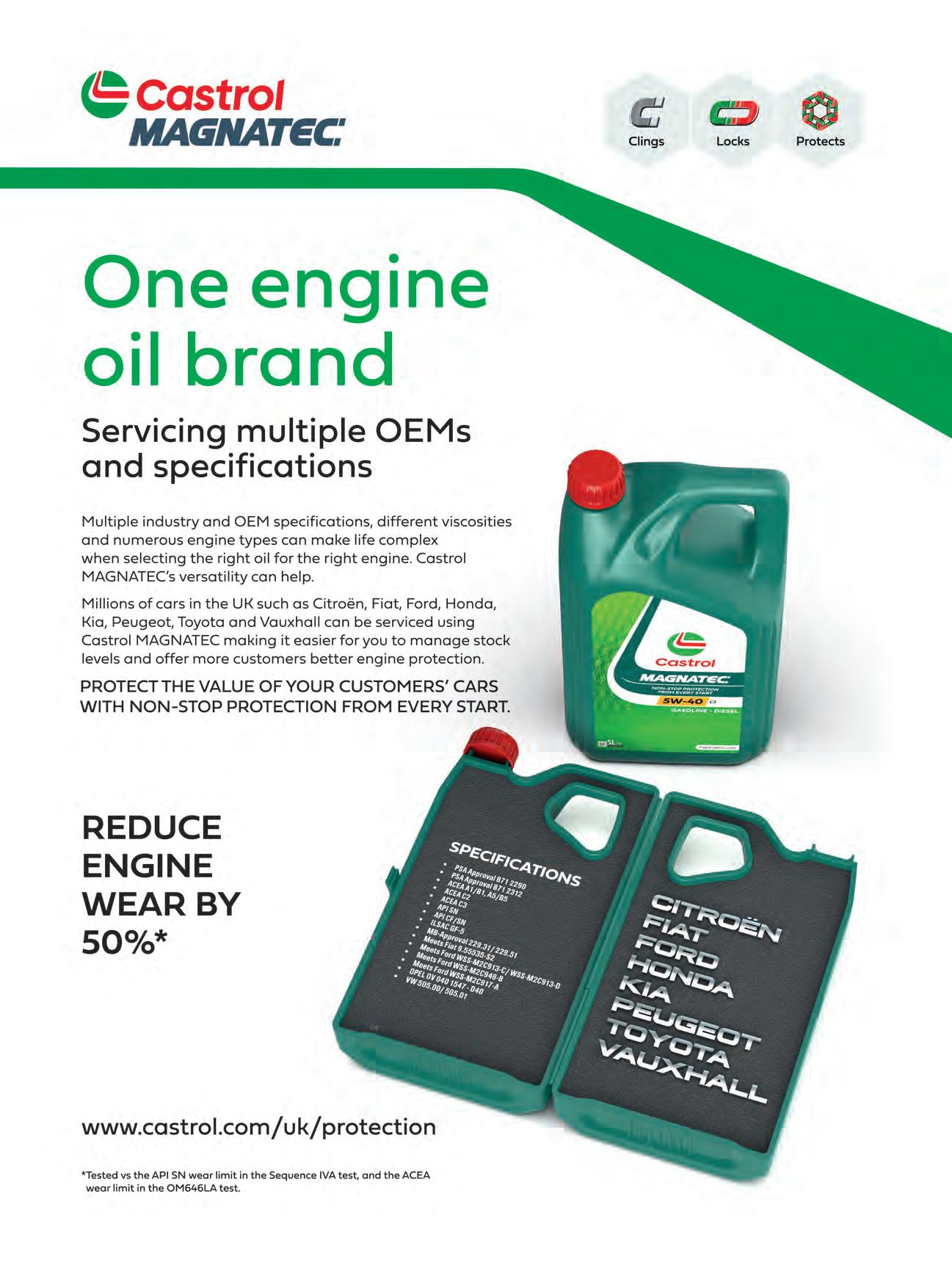


Deal me IN


In an industry where staying ahead of the curve is paramount, Maverick Diagnostics recognises the challenges faced by automotive professionals in getting the most out of every dealer tool. And that’s exactly what Maverick Diagnostics’ dealer tool support aims to do.
Let’s look at the key features of the program from the Maverick helpdesk:
n Expert guidance: Access remote assistance and a dedicated helpline for expert troubleshooting, ensuring swift resolution of technical issues.
n Automated software updates: Fully tested and automated OEM software updates, keeping equipment aligned with the latest advancements from VMs.
n Quick, friendly and experienced assistance: Benefit from a team of seasoned support technicians available during business hours, ready to address queries promptly.
As independent garages continue to find obstacles in the way of diagnosing and repairing vehicles using aftermarket tools, they are increasingly turning to dealer tools, which are often far from intuitive or easy to access. Luckily, Maverick Diagnostics is on hand with its new dealer tool support program, supporting independent garages to be able to offer a comprehensive service to customers.

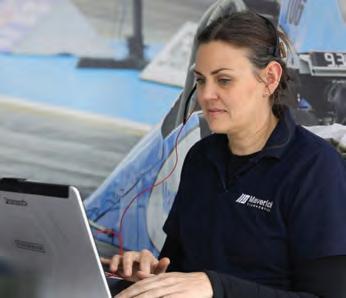
n Experienced troubleshooting: Maverick Diagnostics’ support team offers comprehensive assistance, from registration to complex programming issues, ensuring workshops remain operational without interruptions.
Tried and
tested
Dara Beck, a vehicle technician from Arwyns Garage, is one of the thousands of satisfied customers, maximising the potential of Maverick Diagnostics’ OEM tools – he said: “We’ve been with Maverick Diagnostics since late 2018, and the team have been very helpful in setting up our
OEM tools and licensing.
“We upgraded to cover more VMs. Maverick Diagnostics can ‘remote in’ and assist us with a vehicle where we can work in another vehicle, which saves us time and money. Due to advancing vehicle technology, OEM tools are integral for aftermarket professionals. I highly recommend Maverick Diagnostics, as its products and services have been very beneficial for our garage.”
Workshops owners can choose from a menu of flexible pricing options tailored to their needs, starting from as low as £95 per month, ensuring access to high-quality support without breaking the bank.
Helpfully, workshop owners can calculate their return on investment, thanks to Maverick Diagnostics’ ROI calculator. This, along with more information and case studies, can be found at WWW.RDR.LIN K/ABJ014
PMM JUNE 2024 43
DIAGNOSTICS & ENGINE MANAGEMENT WANT TO KNOW MORE? FOR MORE INFORMATION WWW.RDR.LIN K/ABJ015
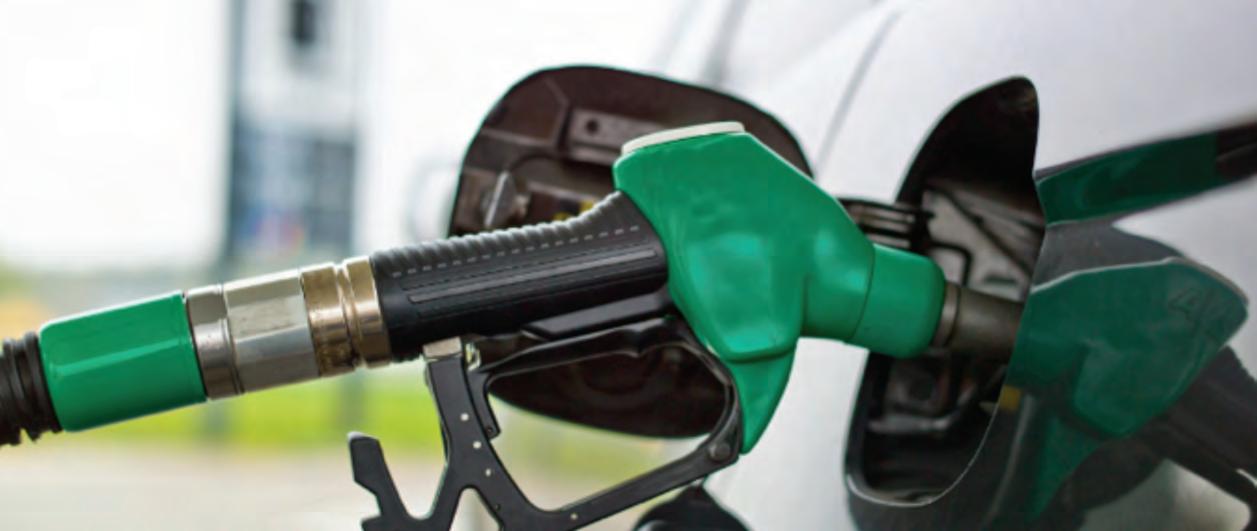
‘OIL’ about fuel types
Understanding the various types of fuel, the oil functions, and how lubrication additives work is essential for drivers to optimise their vehicle's performance.
Petrol: Its fuel is derived from petroleum. It powers various vehicles and machinery globally, but on the other hand, it generates lots of pollution. It comes in different octane ratings denoted by the labels on pumps, affecting combustion and performance. While SUVs and sports cars benefit from higher octane fuel, most vehicles operate fine on regular gasoline.
Diesel: It’s also petroleum-based but refined differently. It powers industrial and off-road vehicles, offering better fuel efficiency than gasoline. Diesel engines, utilise compression to ignite the diesel fuel. The resulting combustion propels the engine's piston, powering the machinery. This innovation facilitated the development of compact engines suitable for smaller vehicles.
Biofuels: This type of fuel is derived from biomass –animal and plant matter –is a sustainable alternative to traditional fossil fuels like diesel. Currently, two primary types of biofuels dominate the market –ethanol, and biodiesel –with emerging varieties like hydrocarbon or “drop-in” fuels on the horizon. Despite being under the umbrella of biofuels, each type undergoes distinct synthesis processes.
Wynn’s Oils gives its advice on different fuel types and how to improve engine performance with oils and additives.
Ethanol: It’s an alcohol fuel, that primarily originates from plant starches and sugars such as corn or sugarcane. Ongoing research explores deriving ethanol from cellulose and hemicellulose, the fibrous, non-edible parts of plants. Typically produced through fermentation, microorganisms break down plant sugars to yield ethanol. Ethanol finds extensive use as a blend with gasoline, significantly reducing emissions, with over 98 per cent of US gas containing it.
Biodiesel: It’s another biofuel variant, is a non-toxic, biodegradable fuel crafted by combining alcohol (often ethanol) with vegetable oils or animal fats. New and used substances, including old restaurant grease, can be converted into biodiesel. Usually blended with standard diesel, the common blend ratio is B20 –20 per cent biodiesel and 80 per cent petroleum diesel.
Hydrocarbon fuels: While traditionally derived from petroleum, it can also be produced from biomass using diverse methods. These fuels resemble petroleum fuels, enabling seamless interchangeability without requiring new engines or machinery. Referred to as drop-in fuels due to their compatibility with existing infrastructure, they offer a promising pathway toward sustainable energy solutions.

Car oil function
Engine oil’s primary function is to lubricate the engine and extract heat from the components to reduce wear. The oil absorbs contamination such as by-products of combustion, unburnt fuel, and moisture. In absorbing these elements, they are held in suspension until removed from the engine at an oil change.
Lubrication additives
Advances in technology and different types of fuel, as we saw, led to changes in engine oils. Driving styles, extended drain intervals, and smaller capacity sumps all contribute to the build-up of contamination. Over time and use the oil becomes acidic and the additives in the oil deplete. The oil can no longer absorb the elements, and this will cause the oil to thicken, reducing flow to moving parts, inability to effectively extract heat, and eventually causing wear to the engine.
OILS, LUBRICANTS & ADDITIVES
44 JUNE 2024 PMM
Tribology is the science and technology of interacting surfaces in motion. In an engine, we see three conditions:
Dry friction is where there is little lubrication, and the surfaces can touch (on start-up)
Boundary lubrication is the slight separation of components by the oil but the rough peaks still touch (normally present at low speeds and during the warm-up period).
Hydrodynamic lubrication occurs when there is a complete separation of the rotating components, and they are fully protected by a film of oil (viscosity and velocity of the oil and the engine dependent).
Cleaning the crankcase during a service will remove deposits, tar, and lacquer from the oil system, allowing the new oil to stick to the internal moving parts and provide adequate

protection to the engine. Cleaning the material surfaces of the engine will allow the new oil to provide a full lubricating film. Removing deposits will allow the new oil not to be compromised by the remaining oil and provide better protection during the service period.
Adding oil system treatments such as Wynn’s hydraulic valve lifter concentrate or Wynn’s super charge, Wynn’s oil system cleaner will assist the engine oil and aim to offer greater protection to the engine to
improve its performance. These solutions are recommended for all petrol and diesel engines of vehicles and stationary equipment with high oil consumption, low oil pressure, and low compression.

K/ABJ016
WANT TO KNOW MORE? FOR MORE INFORMATION WWW.RDR.LIN

CASES CLOSED
David Wright, Company Secretary of the Verification of Lubricant Specifications (VLS) brings PMM readers up to speed on the latest lubricant investigations.


In 2013, reputable lubricant blenders and manufacturers came together to launch VLS, an independent organisation providing a credible and trusted means to verify lubricant specifications, bringing transparency to the lubricant marketplace.
2023 was VLS’s 10th anniversary year, during which the organisation received an influx of cases, the highest since 2015. Several of those cases have now been concluded, and products have been brought into compliance or removed from sale.
VLS 010176 –
0W-30 C2 fully synthetic engine oil
The complaint concerned the product’s performance claims against Fiat 9.55535-GS1 and Fiat 9.55535-DS1 in relation to its volatility characteristics. The complainant alleged that product testing showed that it did not meet a key performance requirement and, therefore, was misleading to the end consumer.
VLS procured and tested an independent sample for Noack volatility (ASTM D5800) and upheld the complaint, as the product did not meet the limit detailed in the Fiat specifications. During its investigation, VLS also found several other issues regarding claims against Chrysler MS-90047, ACEA C2, PSA B71 2312 and BMW LL-12-FE specifications. In response, the named party conducted their
own product testing and an internal review. They removed Fiat 9.55535-GS1 and Fiat 9.55535-DS1 from the “performance profile” of the product. They also agreed to remove claims against Chrysler OEM specifications.
VLS was content that the steps taken by the named party had brought the product into compliance and closed the investigation, subject to a six-month review.
During the six-month review, VLS found that the information presented on the named party’s online shop has not been updated since the end of the investigation, and references remained to the Fiat and Chrysler specifications. VLS asked for these to be amended. As the claims made against Chrysler and FIAT had been removed from the main vendor website and the product's technical data sheet and packaging, VLS was content to close the investigation.
“VLS has investigated over 100 lubricant product complaints, from cold weather properties to compliance with industry standards and market regulations” David Wright, VLS
VLS 010185 –75W-90 fully synthetic manual transmission fluid
The complaint concerned the product’s low temperature properties and its compliance with SAE J306 viscosity standard. The complainant alleged that as the product set solid during low temperature testing, it was not compliant with SAE 75W specification at -40 degrees centigrade and would not provide adequate circulation in gear systems. They also claimed the product did not comply with the SAE 90 limits.
VLS independently procured a product sample within the UK and tested it for low temperature viscosity characteristics against ASTM D2983. The results indicated that the product was not compliant as it did not meet the requirements of an SAE 75W grade as defined in the SAE J306 standard. However, VLS found that the product complied with the higher temperature SAE 90 limits.
The named party informed VLS that they believed the issue was due to batch contamination. Since the sample was produced, they had changed their filling procedures and moved to automated blending which they said had resolved the problem. The named party had checked all batches subsequently manufactured and stated that they were all compliant according to their testing.
OILS, LUBRICANTS & ADDITIVES
46 JUNE 2024 PMM
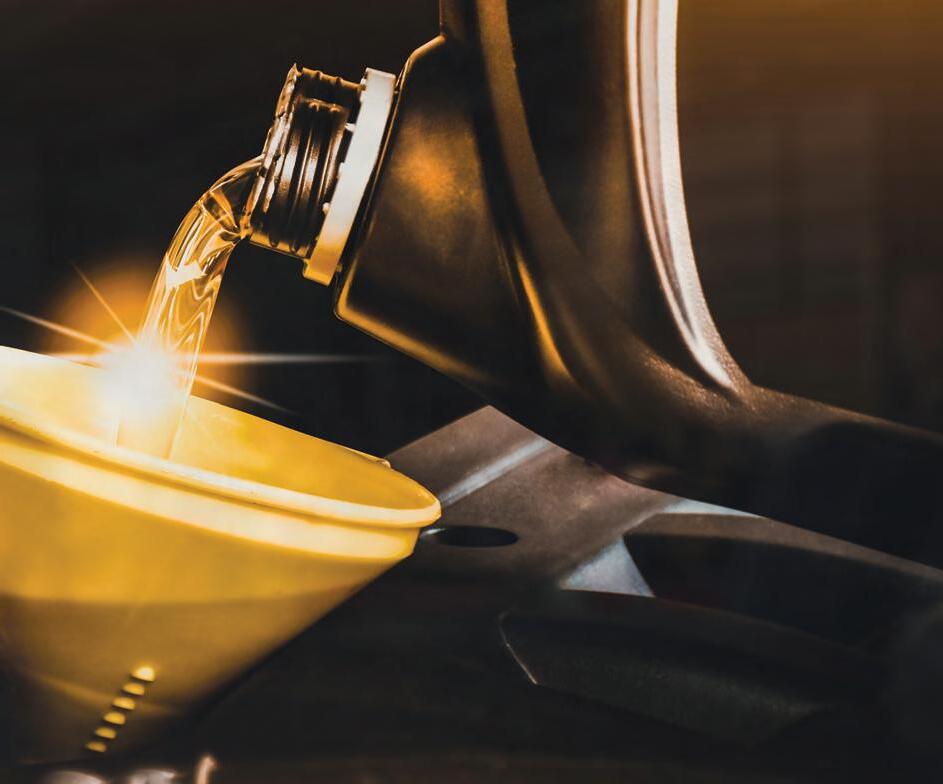
VLS undertook a six-month review, during which a new sample was tested and found to be in continued compliance. Therefore, the case was closed.
VLS 010186 –
75W-90 semi-synthetic gear oil
The complaint concerned the product’s low temperature properties and its compliance with SAE J306 for a 75W grade of gear oil. The complainant alleged that the product was not SAE 75W compliant and would not provide adequate circulation in gear systems as it set solid at low temperatures.
VLS independently procured a sample of the product within the UK and tested it for low temperature properties against ASTM D2983. The results showed that the product turned solid at low temperature and was not compliant with SAE J306 for a 75W product of this type.
The named party immediately quarantined the product and arranged for an uplift by their supplier for further investigation and testing.
VLS believed that the actions taken by the named party had brought the product into compliance, and the investigation was closed subject to a six-month review. During the sixmonth review, the product was found not to be on open sale in the UK, and so the case was closed.
Several other cases remain open and under investigation, including case 010203, a complaint concerning a PCEO claim against VW 504 00/507 00, ACEA C3, BMW LL-04 and MB 229.51
performance specifications and case 010202, concerning an ISO 32 hydraulic oil. Other cases are pending a six-month review to confirm their continued compliance. Three cases have been escalated to trading standards as the named parties have failed to take the necessary action to bring products into compliance.
What you can do
At VLS, we work hard to protect workshops by ensuring we have the highest standards for lubricant manufacture, blending and marketing and a level playing field for all participants. We have set a course for stronger industry self-regulation by working positively towards more open and transparent competition that benefits manufacturers, mechanics and motorists alike. If you are unsure which lubricant to use for a particular vehicle, use vehicle lookup databases online, check handbooks, and ask OEMs or VLS for further clarification. Using the wrong oil risks accelerated wear to gears and bearings, malfunction of emission control devices, higher customer maintenance costs and potential reputation damage.

WANT TO KNOW MORE? FOR MORE INFORMATION WWW.RDR.LIN K/ABJ017

OILS for all
Castrol continues to evolve its lubricant offering to protect a diverse UK car parc.
Many of today’s consumers are finding themselves more disconnected from car maintenance, with many not aware of the importance of ensuring their vehicles are lubricated on a regular and appropriate basis. If vehicles aren’t lubricated correctly, costly repairs can be required if the incorrect oil is used.
15.7 million UK cars can all be serviced using Castrol Magnatec, aiming to allow workshops to simplify their inventory management and ensure the correct compatibility with thousands of vehicles, including many from Citroën, Fiat, Ford, Honda, Kia, Peugeot, Toyota and Vauxhall for better engine protection.
Stop start driving
In recent years, traffic congestion in urban environments has become more severe and places more strain on engines and lubricants. The average driver can stop and start up to 18,000 times a year. The process of stopping, starting, accelerating, decelerating, and idling generates increased microscopic engine wear, with metal fragments worn away from the surfaces of critical engine parts creating damaging particles.

Castrol Magnatec's dualock molecules are said to cling to critical engine parts and lock

together to form a layer of protection, reducing both engine warm-up and re-start wear by 50 per cent.
Castrol has designed a Magnatec ‘case’ master image based on the company’s new product packaging launched last year. In line with Castrol’s PATH360 sustainability strategy, this new packaging uses 20 per cent less plastic for the five-litre bottle, one of the best-selling products in the range. In Europe, the new bottles are
“The average driver can stop and start up to 18,000 times a year. The process of stopping, starting, accelerating, decelerating, and idling generates increased microscopic engine wear ”
expected to save around 1,000 tonnes of plastic per annum compared to the previous small bottle designs and aggregated across the full bottle range. The new marketing assets also aim to showcase Castrol’s new brand identity, including an updated logo. The corners of the bottles have also been transformed into smart ridges, which is said to enhance their sturdiness and durability, while the overall bottle shapes have been optimised to maximise space utilisation on pallets and shelves. This approach to space optimisation includes relocating the handle to the corner of the bottle. As a result, there is now a 28 per cent increase in the number of cartons containing four-litre bottles that can be accommodated on a single pallet. Compared to the previous capacity of 28 cartons, a single pallet can now hold 36 cartons containing five-litre bottles.
Expanding range
Castrol continues to add to the Magnatec range. Last year, the company launched a formulation that has been designed to meet the specific needs of Fiat GS1 and DS1compatible engines, found in models such as the Fiat Panda and 500, Jeep Compass and Renegade, and Alfa Romeo Mito. Castrol magnatec 0W-30 GS1/DS1 is designed for use across all Fiat petrol and diesel vehicles where Fiat recommends an ACEA C2 or earlier specification 0W-30 lubricant. The new product is the first Castrol engine oil to meet Fiat 9.55535-GS1 and Fiat 9.55535DS1 specifications.
PMM JUNE 2024 49
OILS, LUBRICANTS & ADDITIVES WANT TO KNOW MORE? FOR MORE INFORMATION WWW.RDR.LINK/ABJ018

AdBlue Velvet
A new AdBlue additive has been launched by Liqui Moly to help protect the SCR system for exhaust gas treatment against damage.
Anyone who drives a modern series-production diesel has to fill up not only with fuel, but also with urea. Dissolved in water, it is sold under the name AdBlue. Only with this reducing agent can vehicle manufacturers comply with the standards for nitrogen oxide emissions that apply in Europe. No technology without pitfalls: Damage to the exhaust system is possible without appropriate care. This is where DEF anti crystal additive concentrate, newly developed by Liqui Moly, comes in.
Tackling residue
Diesel fuel is required to keep the vehicle moving. AdBlue creates the prerequisites allowing the diesel engine to comply with the legally prescribed nitrogen oxide levels. The reducing agent AdBlue, also known as diesel exhaust fluid (DEF), is injected into the hot exhaust tract in the appropriate doses via a separate tank. “The solution evaporates there.Residues can form because a liquid film forms on the exhaust pipe surface, where the water evaporates faster than the urea can decompose,” says David Kaiser, head of research and development at Liqui Moly. He is responsible for the development of DEF Anti Crystal Additive Concentrate. “The additive lowers the temperature to achieve the so-called Leidenfrost effect. This phenomenon promotes residue-free decomposition of the AdBlue solution. The Leidenfrost effect reduces the formation of a liquid film on the exhaust surface,” continues David Kaiser.
The additive’s sphere of influence is the exhaust gas treatment system, or SCR system for short. SCR stands for selective catalytic reduction. With the help of this technology, the nitrogen oxides produced during the

“AdBlue freezes at temperatures below -11.5°C. With our additive, you can lower the freezing point to around -16°C” David Kaiser, Liqui Moly
combustion process in the diesel engine are converted into elemental nitrogen and water in a catalytic converter. The central component of SCR treatment technology is the dosing system and the pump is at its heart.
Residues can be formed because AdBlue consists of around two thirds demineralized water and about one third urea. When this substance is heated, the organic compounds biuret and triuret are formed by the separation of ammonia. “Urea crystals form in lines or in dosing valves. This happens when the water in the lines evaporates or vaporises,” explains the head of development. In extreme cases, this leads to a blockage in the AdBlue system. This
in turn can cause damage to the pump and injection nozzles or trigger an error message in the engine control unit. “The surfactant contained in the additive reduces the surface tension in AdBlue. It hinders the formation of drops. This prevents the development of unwanted crystals and deposits on the injection nozzle,” says David Kaiser.
Freezing problem solved
Cold sensitivity is the second weak point of the aqueous solution. To protect the SCR system from freezing, the vehicle manufacturers use heaters. However, they are only activated when the engine is started. “AdBlue freezes at temperatures below11.5°C. With our additive, you can lower the freezing point to around -16°C,” David Kaiser explains. Because construction vehicles are often unprotected from the cold on building sites, the risk of breakdown increases in winter. Various construction companies and also workshops had turned to Liqui Moly with the question of a product that would solve the problem. The result is DEF anti crystal additive concentrate. However, the additive only has a preventive effect. Existing crystallisation can only be removed mechanically. In most cases, this is put into practice by the expensive replacement of parts. “That’s why providing information is so important here,” the expert underlines. The new product is available in a plastic container with a capacity of 2.5 litres and in a plastic dispensing bottle with 250 millilitres of capacity.
PMM JUNE 2024 51
OILS, LUBRICANTS & ADDITIVES WANT TO KNOW MORE? FOR MORE INFORMATION WWW.RDR.LINK/ABJ019
Balljoints coveredon

Online
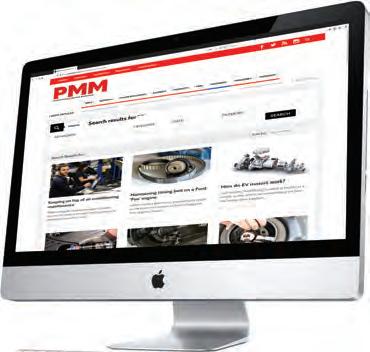
Thanks to PMMOnline, technical guides have never been easier for technicians to access. With no need to sign in, pay or subscribe, PMMOnline offers an invaluable and simple-to-use resource for the aftermarket. Let’s take a look at some technical guides in our extensive digital archive. This month, we’re focussing on ball joints.

OESAA members provide ball joint replacement guide on Ford Transit
OESAA members Laser Tools and Schaeffler provide their guide to removing and replacing the ball joint of a Ford Transit.
The two main causes for premature wear on ball joints are:
1. Lack of lubrication, due to the grease leaking out or being washed out – possibly caused by damage to the protective boot
2. General wear that acceleratesthe onset of excess free play in the joint
With the Transit remaining one of the most popular vans on our roads and often subjected to arduous driving conditions, it is to be expected that at some point in its life, the bottom ball joints will need replacing.
Steering and suspension repairs are ‘safety critical’, so quality should be the dominant factor, not only with the parts being fitted but also with the workmanship involved –it is important to make sure the customer understands this.
Bolt-in style ball joints
The late-model Ford Transit boltin style front lower ball joints are notoriously difficult to remove –
being a very tight fit, even after the securing bolts have been removed. Laser’s ball joint removal and installation tool (part number 8272) is designed to easily extract and refit this bolt-in type of front lower ball joint on the vehicle, removing the need to use heat, hammer blows or a workshop press.
It’s simple to use: just remove the lower arm to ball joint nut, swing the arm out of the way, and then remove the ball joint securing bolts. Assemble the tool according to the detailed instructions supplied, then simply wind out the bush.
All metal ancillary parts are zinc flake coated to protect against corrosion, and it’s clear TPU boots give the strength of plastic with the flexibility of rubber, combined with the latest sealing technology.
Removal
Always refer to the vehicle manufacturer’s instructions for each specific application. It is best practice to replace both
front ball joints as a pair. Support the vehicle with both front wheels off the ground and the front suspension hanging at full droop.
● Remove front wheels and the lower ball joint taper nut.
● Separate the joint from the arm to access the bottom of the hub.
● Remove the two ball joint fixing bolts from the hub.
● Assemble the components of the kit and lubricate the main force screw with molybdenum disulphide grease.
● Ensure that the support rods are screwed in fully.
● Ensure that the ball joint adaptor has been fully screwed onto the ball joint taper thread. Ensure that the top plate threaded adaptor and the support rod nuts and washers are all correctly tightened. Start to pull the ball joint out by turning the bearing nut, while holding the force screw steady.
● Continue turning until the ball joint is fully removed.
52 JUNE 2024 PMM

Delphi talks ball joint servicing
Ball joints are one of the hardest working parts in a vehicle. We asked Delphi Technologies to share its expertise on servicing this stalwart of the steering and suspension system.
There’s no doubt that the humble ball joint lives a hard life. Working every time a vehicle is driven and performing a vital role in connecting steering componentry, the ball joint also must contend with road grime as well as general wear and tear, so it’s no surprise that it’s one of the most changed parts. There are two types of ball joint, which require slightly different approaches when it comes to servicing. Most vehicles are fitted with MacPherson strut suspension systems. This incorporates a single ball joint on each side, positioned between the lower end of the strut and the control arm.
In double wishbone systems, the two joints are located at the
top (upper ball joint) and bottom (lower ball joint) of the suspension system. Given its position, the lower ball joint experiences higher loads as well as increased exposure to dirt and salt, resulting in faster wear. Ball joints are highly durable but need regular inspection for damage and excessive play. If either is present, the ball joint should be replaced. Other common symptoms of a worn ball joint include:
DISCOVER!
Find more technical articles on PMMOnline, scan the QR code below!

Clunking noises coming from the vehicle’s front suspension when driving over bumps or turning. As the joints wear out they become loose in the socket and rattle as the suspension moves up and down. This can also cause excessive vibration from either side of the vehicle or through the steering wheel
The vehicle’s steering wanders from left to right on its own. As the ball joint deteriorates, these symptoms will progressively worsen until the part fails.

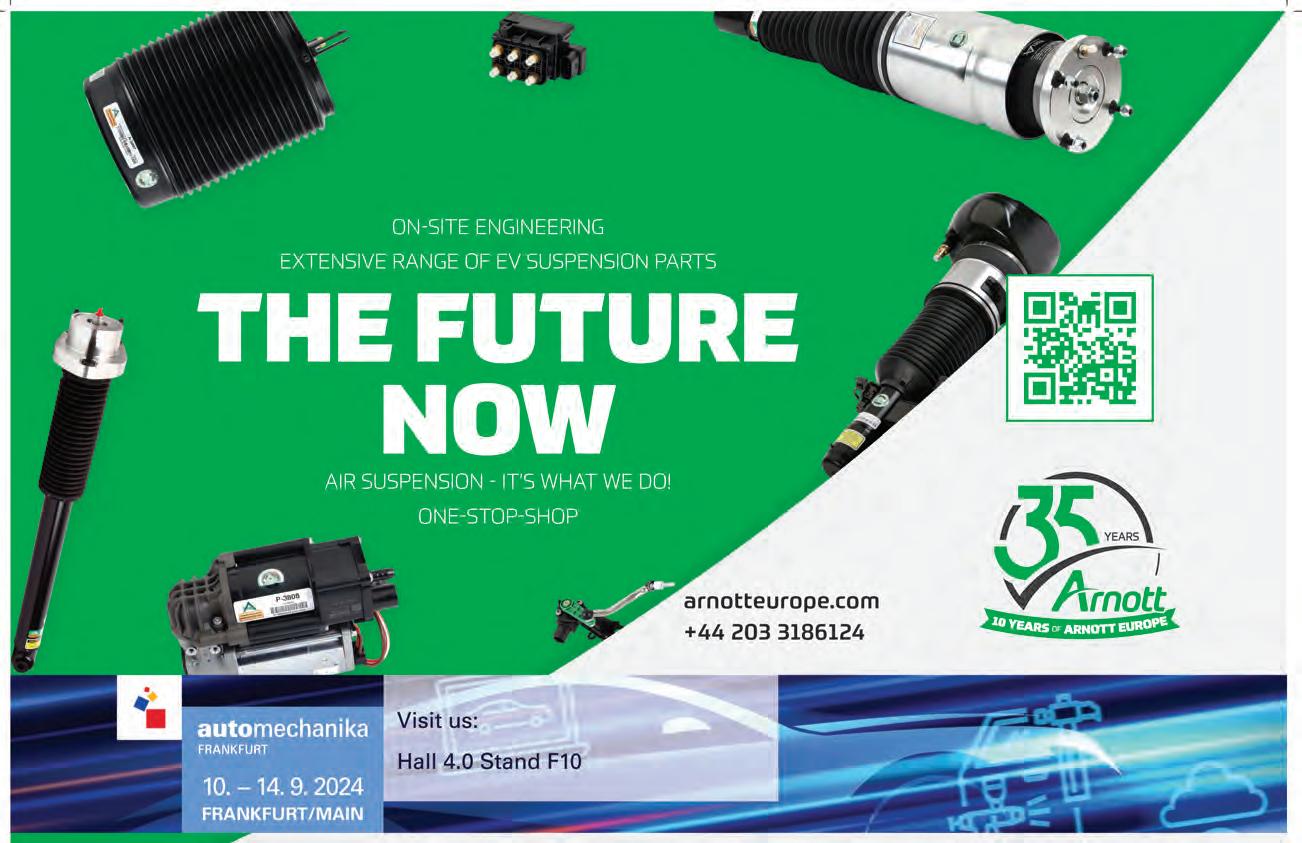
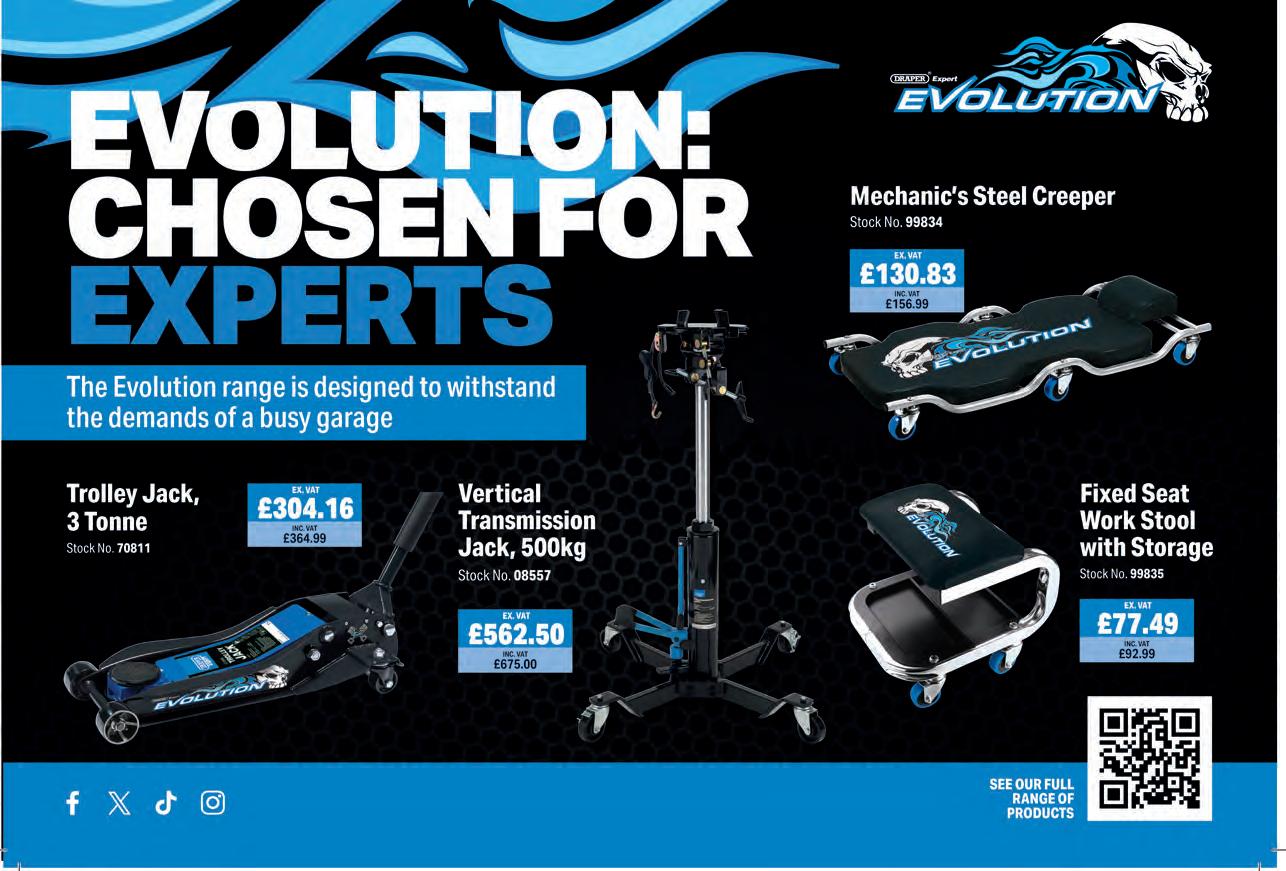
KNOW YOUR PARTS
Stabiliser bars
febi gives aftermarket technicians an overview of an underrated suspension component – the stabiliser bar.
The stabiliser bar is a component of the suspension and connects the wheel suspension of an axle with the body structure. Many cars are equipped with a stabiliser bar on the front axle and some of them with one on the rear axle as well.
Stabiliser bars have been installed in passenger cars for many decades and have remained practically unchanged in this time. The stabiliser bar (or anti-roll bar) is little known to many motorists, although this component plays a significant role in ensuring a safe and comfortable journey. The simple reason: Without a stabiliser bar, vehicles would overturn in corners and driving comfort would be drastically reduced when driving straight ahead as well. As a rule, even knocking noises from the suspension can be attributed to a fault in the stabiliser bar area.
Failure of, or damage to, the stabiliser bar is mostly inexpensive. This is due to the relatively low material costs and straightforward installation. But beware: If the stabiliser bar is damaged, the vehicle should not be moved. Failure increases the risk of the rolling motion of the body structure, getting out of control and the vehicle overturning.
How does it work

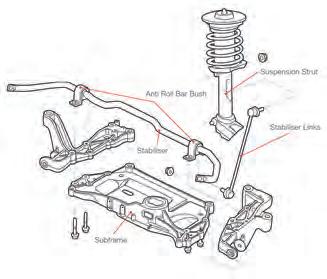
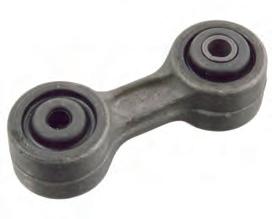
stabiliser links ensure the necessary freedom of movement to allow the stabiliser bar to do its job flawlessly.
When a wheel deflects, the torsion of the stabiliser bar ensures that the other wheel is also raised and likewise lowered upon rebound. This prevents excessive rolling (lateral tilting) of the body when cornering. If the two wheels deflect simultaneously, the stabiliser bar does not activate.
What can go wrong?
The stabiliser system also consists of other components, e.g. stabiliser links and stabiliser bearings. The stabiliser bar is mostly mounted on a subframe and in rubber bearings. The stabiliser links connect the stabiliser bar to the suspension struts or, alternatively, to the control arms. Special ball joints on the
In the event of failure or damage to the system, loud knocking noises frequently occur in the suspension when driving over bumps or potholes. These are mostly caused by worn bearings or defective ball joints on the stabiliser links. In the case of worn bearings, an unintended play arises between
bearing and stabiliser bar, and the stabiliser bar begins to rattle in the bearings on deflection and rebound.
A frequently installed type of stabiliser link features ball joints that are protected by a rubber boot from spray water and external influences. They are also packed with grease to make the movement as frictionless as possible. Every now and then, the rubber boot or the associated seal is damaged. This allows water to enter and provides for unnaturally high wear. The consequence: too much play in the joints, which leads to the noises mentioned above.
When replacing the stabiliser link, it must always be ensured that the correct torque is applied during installation. Otherwise, the ball joint can be damaged, wear prematurely or even break off.
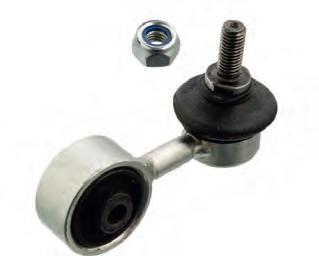
PMM JUNE 2024 55
STEERING & SUSPENSION WANT TO KNOW MORE? FOR MORE INFORMATION WWW.RDR.LINK/ABJ020
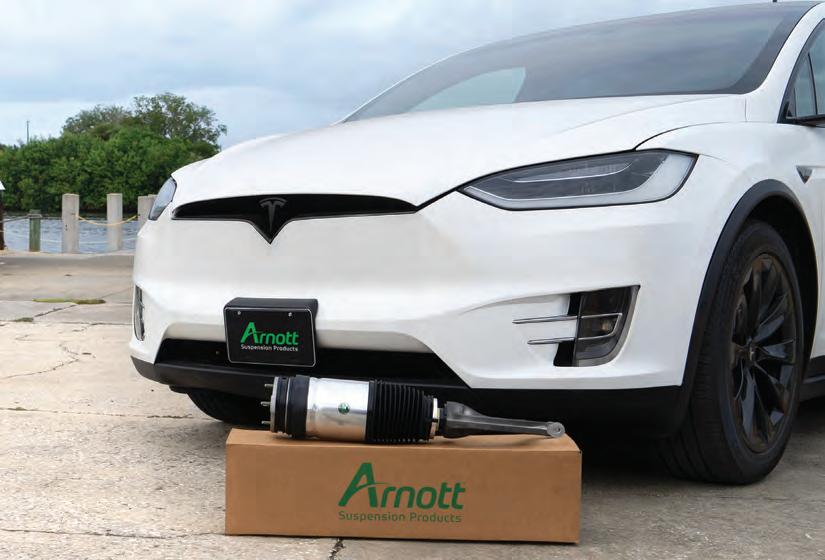
In
this article, Arnott investigates the impact increased adoption of electric vehicles is having on air suspension technology.
Suspension for EVs
The most obvious difference between a vehicle with an internal combustion engine and an electrical vehicle is that an ICE ignites and combusts fuel (spark-ignited for gasoline engines or compression-ignited for diesel engines) while an EV uses a battery powered electric motor for propulsion. This difference in powertrain impacts the vehicle in several areas, for example there are fewer moving parts in an EV because of the electric motor, with no exhaust pipe or DPF for example.
Although EVs are generally heavier and have a lower point of gravity than ICE vehicles, the suspension system of EVs did not undergo dramatic changes. In reality, the conventional coil strut and spring/shock absorber set-up, or air suspension set-up (whether or not accompanied with adaptive damping technology) looks very similar to the set-up used in ICE vehicles. Nevertheless, different set-ups and technologies are still platform-specific meaning shocks are tuned to optimise for trim level, have different damping curves/shock settings, etc. just like ICEvehicles.
“Although EVs are generally heavier and have a lower point of gravity than ICE vehicles, the suspension system of EVs did not undergo dramatic changes.”
From a practical standpoint, due to the similar suspension set up, a mechanic can repair and replace suspension system components of an EV as easily as on an ICE vehicle. No additional EV specific special tools or training are required since the suspension is not part of the high voltage system.
EV specific suspension
One of the unique characteristics of electric vehicles is their increased weight and alternative weight distribution within the vehicle caused by battery packs, the position of the traction motors, etc.
Air suspension technologies have commonly been used in ICE vehicles to combat load differences and to optimise the ride and handling in varying driving conditions. The air suspension’s autoleveling capability is the reason why manufacturers design their EVs with air suspension to obtain the desired ride and handling features while maintaining a high level of comfort for the occupants.
A second challenge for EVs is the travel range, which is affected by the amount of electricity the battery can store and how efficiently it is used. Some factors that have influence on the range are the driving conditions and ambient temperature, eco/sporty driving style, use of electronic systems such as the air conditioning or heating, the total vehicle weight (including the occupants and additional cargo) and the drag. To maximise the travel range capacity,
EV manufacturers opt for air suspension because it can contribute to lower fuel consumption. Air suspension can lower the vehicle body at high speeds. This decreases the drag coefficient of the vehicle thereby potentially increasing the travel range.
With the increase in electrification of the car park, we will most likely also see an increase in the use of air suspension systems as the EV market takes advantage of the beneficial characteristics of these systems.
For Arnott’s team of engineers, developing suspension for EVs is a natural evolution from what they have been doing for decades. With an Arnott-owned test lab, test track and fleet, the engineering and prototype teams can take an idea from a white board to a complete concept, producing prototypes and being able to drive those prototypes on the vehicle. Each design is then independently evaluated by other engineers who will do a similar, independent ride evaluation. This feedback loop continues until what they deem the “perfect ride” is accomplished. This proven track-record in engineering, designing, and manufacturing air and suspension aftermarket components is now extending into reliable and longlasting suspension solutions for EVs.
STEERING & SUSPENSION
56 JUNE 2024 PMM WANT TO KNOW MORE? FOR MORE INFORMATION WWW.RDR.LINK/ABJ021
BILS TEIN B3 COIL SPRINGS: PERFECT OE REPLACEMENT IN UNCOMPROMISING QUALI TY
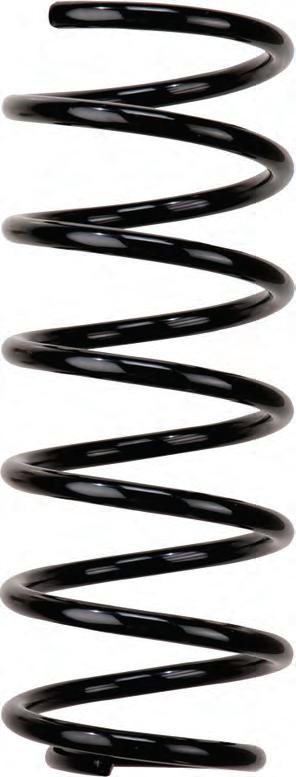
The average age of cars registered in the UK is around ten years old, according to the European Automobile Manufacturers’ Association (ACEA). With increasing mileage and vehicle age, the vehicle springs also wear out. In addition, steel springs are affected in winter: mechanical grit and stone chips can damage the surface, leading to corrosion. Road salt, which then comes into direct contact with the spring steel, further accelerates corrosion. For these reasons it is important that workshops check the coil springs regularly, especially in springtime – for more safety and ride comfort. This check also offers a good opportunity for potential additional business.
A visual inspection of the springs from all sides for rust or hidden cracks is quickly done with the telescopic mirror. Why not take this opportunity to check if the water drainage holes of the spring plate are clogged with road dirt. The customer will appreciate this service, provided that the spring is still in working order. Checking the springs also makes sense for modern vehicles, as high safety standards, such as crash-optimised bodies equipped with restraint systems, hybrid drives, larger brakes and wider tyres, increase the vehicle’s weight and therefore put significantly more strain on the suspension springs.
Want to know more? For more information WWW.RDR.LINK/ABJ022 FOR MORE SAFETY AND RIDE
l extremely high break resistance by using particularly high-quality chromevanadium or chrome-silicon steels
l optimum corrosion protection by highquality and robust surface coating of the spring steel
l precise production: no loss of height after assembly
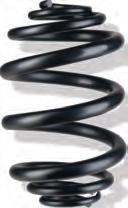
As the BILSTEIN B3 range includes all technical designs such as pigtail ends, central force designs and miniblock springs, it offers a very high degree of market coverage.
The assembly is a criterion that deserves special attention. Suspension springs need to be precisely fitted and correctly installed so that the customer receives an optimal suspension. This is why BILSTEIN supplies detailed vehicle-specific installation instructions showing the installation step by step.
TIP
even if only the spring on one side of the vehicle is affected by damage, the springs (and shock absorbers) always have to be replaced on both sides of the axle. Otherwise, safe handling is not ensured.
In order to withstand these loads for as long as possible and offer good ride comfort, BILSTEIN relies exclusively on spring designs that are identical to those used in OE production:
The result? Correctly mounted BILSTEIN B3 coil springs ensure smooth and safe handling and offer a level of comfort and performance as if the vehicle had just come off the line.
ADVERTORIAL
The BILSTEIN B3 coil springs correspond exactly to original equipment in terms of technology and quality.
B WWW.FACEBOOK.COM/BILSTEIN.UK D WWW.INSTAGRAM.COM/BILSTEIN F WWW.YOUTUBE.COM/BILSTEINDE I WWW.BILSTEIN.COM
COMFORT
The BILSTEIN B3 range includes all typical coil spring designs, such as the miniblock spring shown here.



AND THEY'RE OFF...
Kalimex is offering one reader of PMM and their family a great opportunity to get stuck in with a championship-winning race team this year.
Kalimex is supporting two entries in the UK Legends and Legends Elite Championship (sponsored by JLM) in 2024. Jack Parker (3rd in the 2023 Elite Championship) will be driving the Number 4 JLM Lubricants’ car and Oli Schlup (4th in the 2023 UK championship and winner of the most improved driver trophy in 2023) will be piloting the number 9 K-Seal car. Both drivers are aiming high for a championship win this season.
This year marks the 30th anniversary of the UK Legends Car championship with the stage set for it to be the best ever! There are 13 rounds held over seven weekends including three rounds supporting the British Touring Car Championship. Legends Car races are regarded by many as some of the most exciting in the UK with more overtakes in a single weekend than a whole season of F1 not to mention the near misses that have everyone on the edge. The cars are fitted with special bumpers to allow them to ‘bump and draft’ on the straights, just like in Nascar racing, so it truly is bumper to bumper action all day.
The season kicks off at Donington Park on 27-28th April (BTCC) before moving on to Brands Hatch in May (BTCC) with further events at Snetterton, Knockhill (BTCC) and Oulton Park.
Your chance to get involved
PMM has a rare prize opportunity for one lucky winner and their family (two adults and up to three children below 13) to spend a daywith a world championship winning race team, thanks to sponsors JLM, K-Seal and Quiksteel. Team principal John Mickel, the five time UK and three time World Legends champion has over 40 years of racing experience and will share his tips for race car preparation with the lucky winner. The winner will also be able to sit in a race car to see what it feels like from a driver’s perspective. Plus, they can even get their hands dirty helping to prepare the cars in between races, whether that’s changing wheels, helping with the suspension set up or even fixing race damage in double quick time to get the cars ready for the next race. Food and refreshments are included in the prize package. The winner will also receive exclusive goodies including limited edition team clothing.
The winner will be able to choose from one of the following events which take place around the UK:
8-9 th June– Brands Hatch (American Speedfest)
10-11th August – Knockhill (BTCC event)
7-8th September – Snetterton
28-29th September – Oulton Park
K-Seal permanent Coolant Leak Repair is the number choice for professional mechanics for repairing leaks in all hard parts of the cooling system, including the head gasket. Quiksteel Epoxy Putty is the only quick cure/high temperature resistant formula in the UK and is perfect for emergency and permanent repairs for all cars, vans and HGVs. The JLM Lubricants range of professional diesel, petrol and hybrid additives means that mechanics and motorists can quickly fix a whole range of emissions problems and prevent future problems from recurring. JLM also supplies dedicated DPF Cleaning Toolkits which allow a DPF to be cleaned and restored on a vehicle in less than two hours. No need to remove the DPF or send it away.
For more information
WWW.RDR.LINK/ABJ023
How do you enter?
To enter, WWW.RDR.LINK/ABJ034 and answer the question below:
Q. The UK Legends Car championship celebrates which anniversary this year?
a. 25 years
b. 30 years
c. 35 years
Entries close on 31st June.
59 JUNE 2024 PMM COMPETITION
WIN!
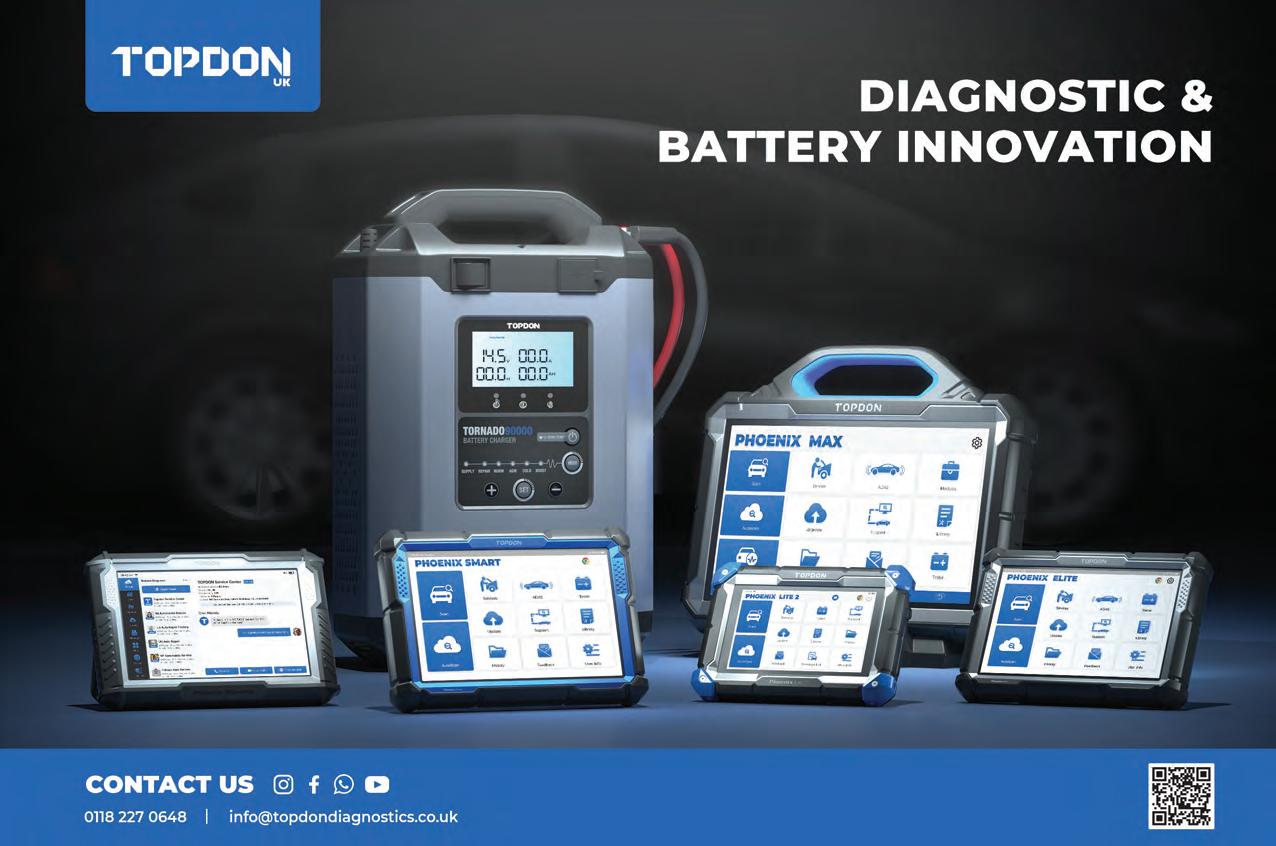

PRODUCT SPOTLIGHT
Traction Direct’s workshop trolley
PMM shines a light on Traction Direct’s new modular workshop trolley.
Branching out
Traction Charger have recently rebranded to Traction Direct, hoping to open up the opportunity to branch out into accessories to complement its range of battery chargers, battery support units and showroom support units. It has recently introduced a new modular workshop trolley, designed for ease-of-use in the workshop with a slimline design for easy manoeuvrability.
Extra kit
Storage space
This Trolley comes in response to many Traction customers citing their current workstations are cumbersome and can’t hold all the necessary equipment. The Traction Direct Workshop Trolley is 460mm width max, with a rear cable hangar and four independent sockets. The trolley can hold multiple Traction chargers and units on the reverse, bottom and top plate.
A laptop kit is available comprising a smooth top plate and storage shelf with the option to purchase a VESA arm. The company can also supply a monitor and trackpad keyboard if required. For heavier accessories up to 400mm wide the EV kit would be a good option.
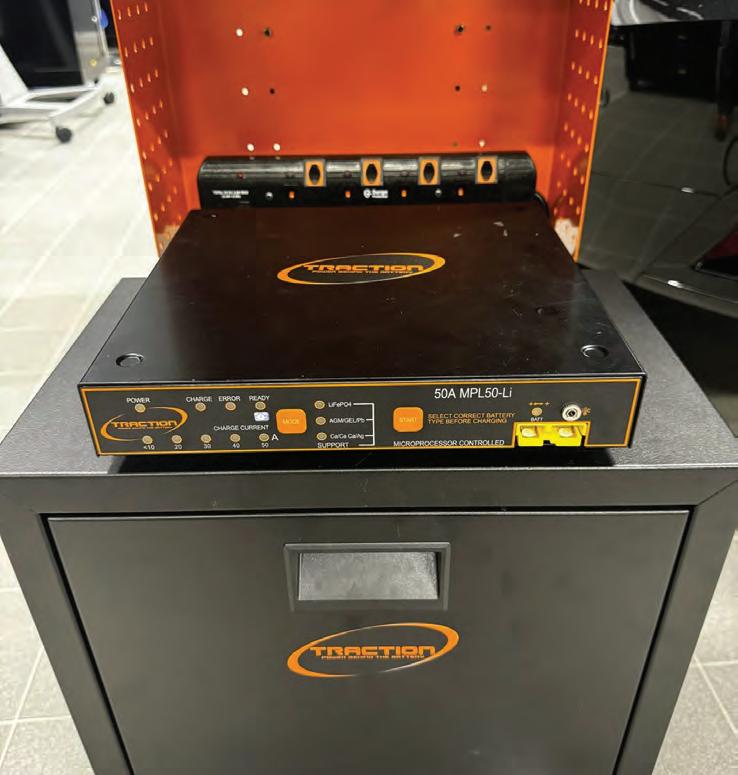
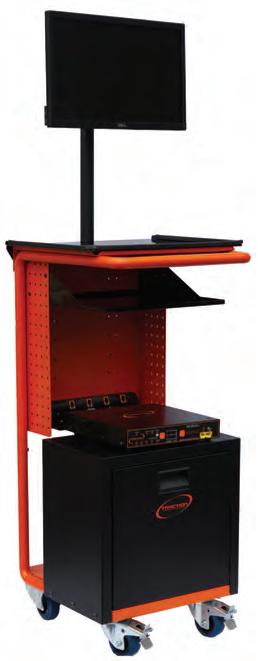
Laptop room
The top plate can also be utilised for laptops, and if you add the VESA arm for a monitor it will allow you a larger visual of your screen during tasks. This is especially important during diagnostics work.
PMM discount
There are three build options available, from the basic Trolley to the EV Trolley through to a full Diagnostics Trolley. All can be ordered through its online site at WWW.RDR.LINK/ABJ024. Traction Direct is offering 15 per cent off for all PMM readers who pre-order this Trolley when they apply code TROLLEYPMM at checkout before June 30th
PMM JUNE 2024 61 PRODUCT SPOTLIGHT
What’s new IN THE WORKSHOP?
with Freya Coleman
Read
oil about it
Castrol

Castrol has refreshed its core POWER1 motorcycle and scooter lubricant range with a new 3-in-1 formula, distinctive new labels, and updated packaging aimed at better suiting the needs of workshops and consumers. The refreshed POWER1 lubricant range supports an array of uses for motorcycles and scooters and aims to perform across three critical areas: excellent power and acceleration, excellent protection, and smooth riding. Besides the new formulation, packaging for the range now features Castrol’s refreshed brand identity that was launched in 2023. It also includes customer-centric labelling aimed at helping consumers easily locate the right product for their motorcycle or scooter. The packaging for Castrol’s small pack product range in Europe has been updated to use less plastic. The company’s new five-litre bottle uses 20 per cent less plastic compared to the previous five-litre bottle4. WANT TO KNOW MORE?
WWW.RDR.LIN K/ABJ025
Liqui Moly
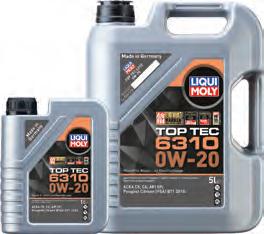
With Top Tec 6310 0W-20, Liqui Moly is launching a new motor oil on the market that meets the requirements of the PSA Group (PSA B71 2010), among others. It is primarily intended for petrol, petrol/hybrid and diesel engines from the model year 2018 for Citroën, DS, Fiat, Jeep, Opel, Peugeot and Vauxhall vehicles. This oil is required for PSA engine types that require a lubricant of specification PSA B71 2010. These engines are used by various brands of the Stellantis Group. This low-viscosity lubricant helps particularly small engines from these series to achieve the best possible performance with low wear. The new product aims to master the balancing act between maximum fuel savings and an extremely thin but durable lubricant film. WANT TO KNOW MORE?
WWW.RDR.LIN K/ABJ026

EV tool range
With independent garages seeing more EVs as existing cars reach the aftermarket and the sale of new EVs continue, Thinkcar UK is looking to support workshops through an ever-widening range of EV specialist tools.
The range includes diagnostic tools, battery chargers, specialist lifts and more. The Master CE EVD is a dedicated EV diagnostic tool, which aims to provide comprehensive for electric vehicles. Then there is the Bolt-On EV Kit which expands the ability to diagnose off-the car for the Thinkcar Euro Max and Euro Master X. The EVP 802 battery pack equaliser balancer helps to maintain battery packs in a wide range of EV vehicles, aiming to ensure they operate efficiently and have a longer lifespan. On the charger front, there is the EVP 902 battery charger. Lastly, safely lifting EV batteries is a concern for garages which is where the EVP501 comes in.
WANT TO KNOW MORE?
WWW.RDR.LIN K/ABJ027
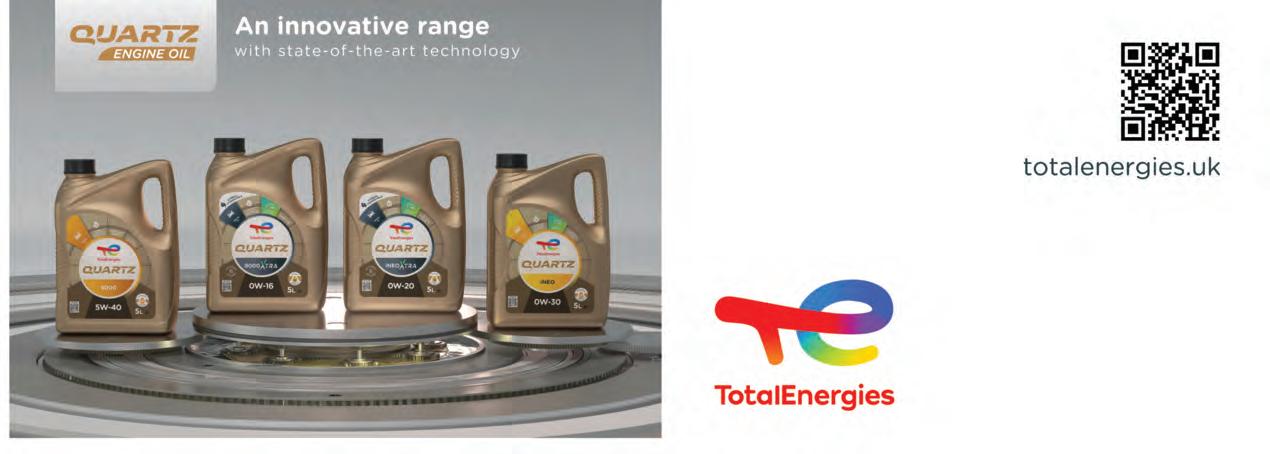
MESSAGE ME YOUR PRODUCT RELEASES OR YOUR FAVOURITE PRODUCTS AT FCOLEMAN@HAMERVILLE.CO.UK
EV brakes

Dent puller kit
Glue pulling is an ideal repair process when there is restricted access behind the dent to be repaired, and when used with care the paintwork will not be damaged. A new addition to PowerTEC’s range is the 92676 dent-puller kit, a 34-piece set designed for hand-operated dent pulling without compromising the vehicle's paintwork. The puller features adjustable feet for precision placement and control: the kit comes with two pairs of adjustable feet (pull-plates), offering a remarkable 30° of movement. The kit is
Delphi has now launched first-to-market rear brake pads (Delphi reference number LP5034EV) for Tesla’s Model 3 03/2022> and brake shoes (Delphi reference number LS2197) for Volkswagen’s ID. Buzz, ID.3, ID.4 and ID.5 01/2021>. Other first-to-market braking components recently released by Delphi include front brake pads (Delphi reference number LP3843) for MercedesBenz CLE200 and CLE220 10/2023>, rear brake pads (Delphi reference number LP3695) for Honda’s Jazz 03/2023>, rear brake shoes (Delphi reference number LS2080) for Volkswagen’s Amarok 09/2022>.
WANT TO KNOW MORE?
WWW.RDR.LIN K/ABJ028

specifically for use with a hot-melt glue gun, making it an integral part of a paintless dent repair system. Included in the kit: 28 assorted glue pads, providing the adhesive strength needed for various dent sizes and shapes. Two sets of adjustable feet and a hole-straightener attachment, allowing for the repair and compression of edges around holes in bodywork panels for a seamless finish.
WANT TO KNOW MORE?
WWW.RDR.LIN K/ABJ029
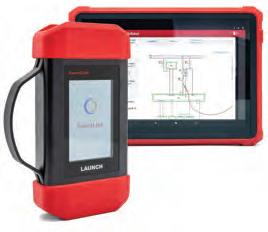
Diagnostic device
Launch Tech UK has launched its latest diagnostic tool, the X-431 Euro Link with SmartLink remote diagnostics, offering both local diagnostics and the possibility of remote diagnosis using original equipment (OE) equipment in one device. The new addition passes on all of the company’s advantages in diagnostic technology from the X-431 Euro Pro 5, such as wide car model coverage, powerful test function, accurate test data, plus 35 service functions and resets. From basic maintenance tasks to advanced diagnostics, the new X-431 Euro Link provides garages with a versatile tool to streamline daily operations. Features include SmartLink C which is equipped as standard VCI and supported by the brand’s remote diagnostics system, a cloud print feature allowing easy backup and access to all DTC/ADAS reports online and diagnostics assistance. WANT TO KNOW MORE? WWW.RDR.LINK/ABJ030
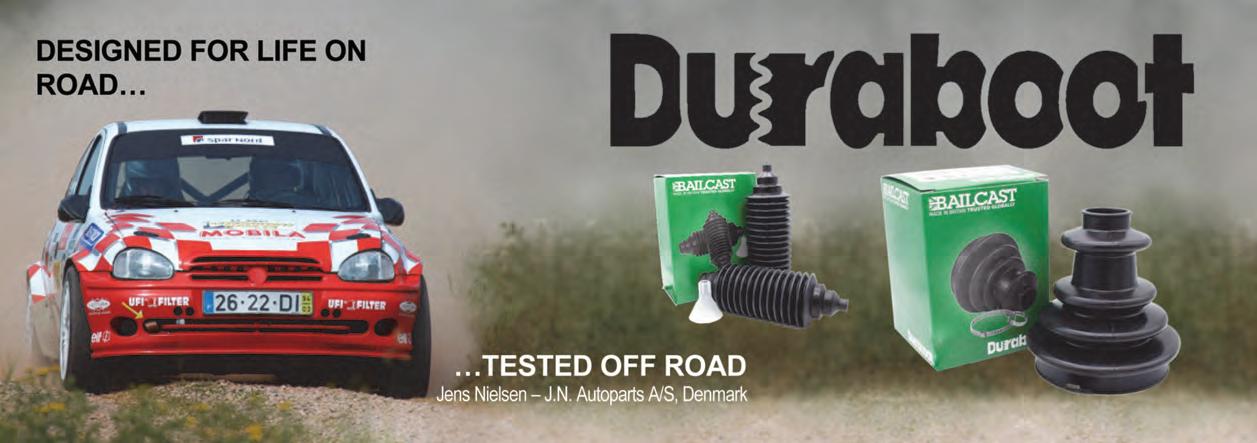
What’s new IN THE WORKSHOP?
with Freya Coleman
Spark plug socket Jump starters
Working on the Ducati V4 engine?
Tried changing the spark plugs? The plugs used on these engines are among the smallest on the market with an M12 bi-hex (12pt) body. Access to the spark plugs is very restricted which means that spark plug removal requires a very compact socket, thus ¼” drive with a tapered body. Laser Tools to the rescue with its spark plug socket (part number 8800) that has been specifically designed to fit the spark plugs used in Ducati V4 engines. The socket is manufactured from high-strength chrome moly steel, and is just 65mm long and 16mm diameter at its widest point — just what you need to access these plugs.
The Ducati applications include: Diavel V4 and Multistrada V4 (from 2023), Street Fighter V4 (from 2020), Superbike Panigale (from 2019) and the Superbike Superleggera (from 2021). Equivalent to OEM 88713.3633.
WANT TO KNOW MORE?
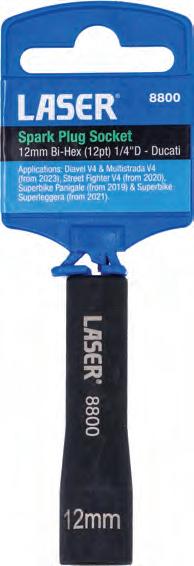
WWW.RDR.LINK/ABJ031
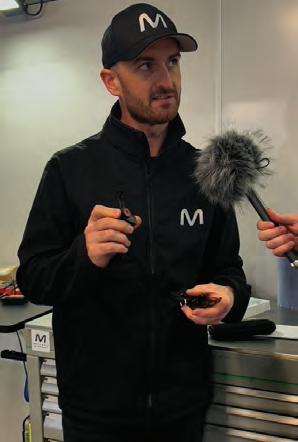
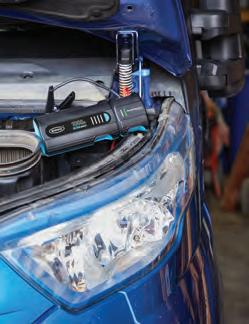
These latest additions from Ring to its compact Lithium jump starter range feature an ‘ultraboost’ button, which when pressed delivers enough power to start completely flat batteries, as low as 0.7 of a volt. The jump starters in this offering also have a unique design that sees the charging leads connect on the end, not out of the side like most others in the market, creating a seamless design. There are three jump starters in this range, all differing in power and capabilities.
All of these are suitable for start/stop batteries and have a clamp connection, which is equipped with longer cables to improve accessibility for harder to reach batteries. Ringtelligence technology for safer vehicle maintenance, is included in all three units with the design of the clamps offering reverse polarity, antispike and short circuit protection. There is also an integrated torch that illuminates the work area whilst the LED indicators display the current battery level.
WANT TO KNOW MORE?
WWW.RDR.LINK/ABJ032
RideorDieTool
We popped up to Warwickshire to visit Darren Quinn from Mechanic Mindset, a platform offering diagnostic training. With over 2,000 members, Mechanic Mindset features a variety of training videos on various diagnostic topics and a community page where users can share and solve issues. Darren also offers monthly live training where he replicates faults and take viewers through the diagnostics. Whilst there, we learnt all about his ride or die tool: “ IF YOU KNOW US, YOU KNOW WE DO ABSOLUTELY LOVE PICOSCOPE OSCILLOSCOPES. HOWEVER, THIS LITTLE THING HERE IS A THERMAL CAMERA AND YOU CAN PLUG IT INTO YOUR PHONE. THERE’S LOTS OF DIFFERENT THERMAL CAMERAS LIKE IT HOWEVER I LIKE THIS ONE. THE REASON I LIKE IT SO MUCH IS IT’S PRETTY MUCH A CHEAT CODE FOR BATTERY DRAIN DIAGNOSTICS. BATTERY DRAIN CAN BE QUITE A LENGTHY DIAGNOSTIC
AT TIMES HOWEVER WITH THIS LITTLE THING, LEAVE YOUR CAR OUTSIDE OVERNIGHT, COME BACK IN THE MORNING, POINT IT AT THE CAR AND IN MANY CASES, YOU WILL FIND WHERE THE BATTERY DRAIN IS COMING FROM IN SECONDS! ”
MESSAGE ME YOUR PRODUCT RELEASES OR YOUR FAVOURITE PRODUCTS AT FCOLEMAN@HAMERVILLE.CO.UK
Wheel nut remover kit
New from Laser Tools is a locking wheel nut removal kit (part number 8842), your solution for tackling stubborn, damaged rounded-off wheel bolts, or locking wheel nuts or bolts when the key is lost. The kit features eight sizes of internally threaded and tapered removal sockets; a suitablesized removal socket is hammered over the offending wheel nut or bolt and it is then simply unscrewed using the appropriate wheel brace or socket and breaker-bar. An air-hammer adaptor is also provided to speedily fit the removal socket if required.

The damaged wheel nut is then pressed out of the removal socket using the supplied extraction screw — this is particularly useful when using the kit at the roadside. This set comes in a sturdy metal carrycase for easy storage and transport.

The tools are mounted in a foam insert which can also be removed from the case for convenient tool tray storage. WANT TO KNOW MORE?

WWW.RDR.LIN K/ABJ033
Here is a useful summary of all the adverts that appear in this issue of Professional Motor Mechanic Each is listed with its page number and a direct URL that will get you straight to the relevant online information
AC Tronics Ltd .............................................................. (page 32)
www.rdr.link/ABJ100
Arnott Europe (page 54) www.rdr.link/ABJ101
Autotech Recruit (page 47)
www.rdr.link/ABJ102
Bailcast (page 63) www.rdr.link/ABJ103
Borg Warner (page 24) www.rdr.link/ABJ104
Castrol (UK) Ltd (page 42) www.rdr.link/ABJ105
Draper Tools Ltd (page 54)
www.rdr.link/ABJ1006
Ecobat Battery Technologies .......................................... (page 60) www.rdr.link/ABJ107
Esprit (page 41) www.rdr.link/ABJ108
Ferdinand Bilstein UK Ltd (page 4) www.rdr.link/ABJ109
Garage Services Online .................................................... (page 7) www.rdr.link/ABJ110
Hella Ltd (page 58)
www.rdr.link/ABJ111
Impact Diagnostics (page 38)
www.rdr.link/ABJ112
Jack Sealey Ltd (page 27)
www.rdr.link/ABJ113
KYB Ltd ........................................................................ (page 53)
www.rdr.link/ABJ114
Liqui Moly UK .............................................................. (page 45) www.rdr.link/ABJ115
Lucas Oil Products Ltd (page 68/OBC) www.rdr.link/ABJ116
MAHA UK (page 9) www.rdr.link/ABJ117
Mann & Hummel (UK) Ltd (page 11) www.rdr.link/ABJ118
Mechanex (page 18) www.rdr.link/ABJ119
Meyle UK (page 12) www.rdr.link/ABJ120
Motul (page 48) www.rdr.link/ABJ121
Pico Technology ............................................................ (page 34) www.rdr.link/ABJ122
PMM Podcast (page 14) www.rdr.link/ABJ123
Schaeffler Automotive (page 2/IFC) www.rdr.link/ABJ124
Topdon UK .................................................................... (page 60) www.rdr.link/ABJ125
TotalEnergies Marketing UK Ltd (page 62) www.rdr.link/ABJ126
Traction Direct Co Ltd (page 37) www.rdr.link/ABJ127
UFI Filters (page 65) www.rdr.link/ABJ128
ADVERTISEMENT INDEX

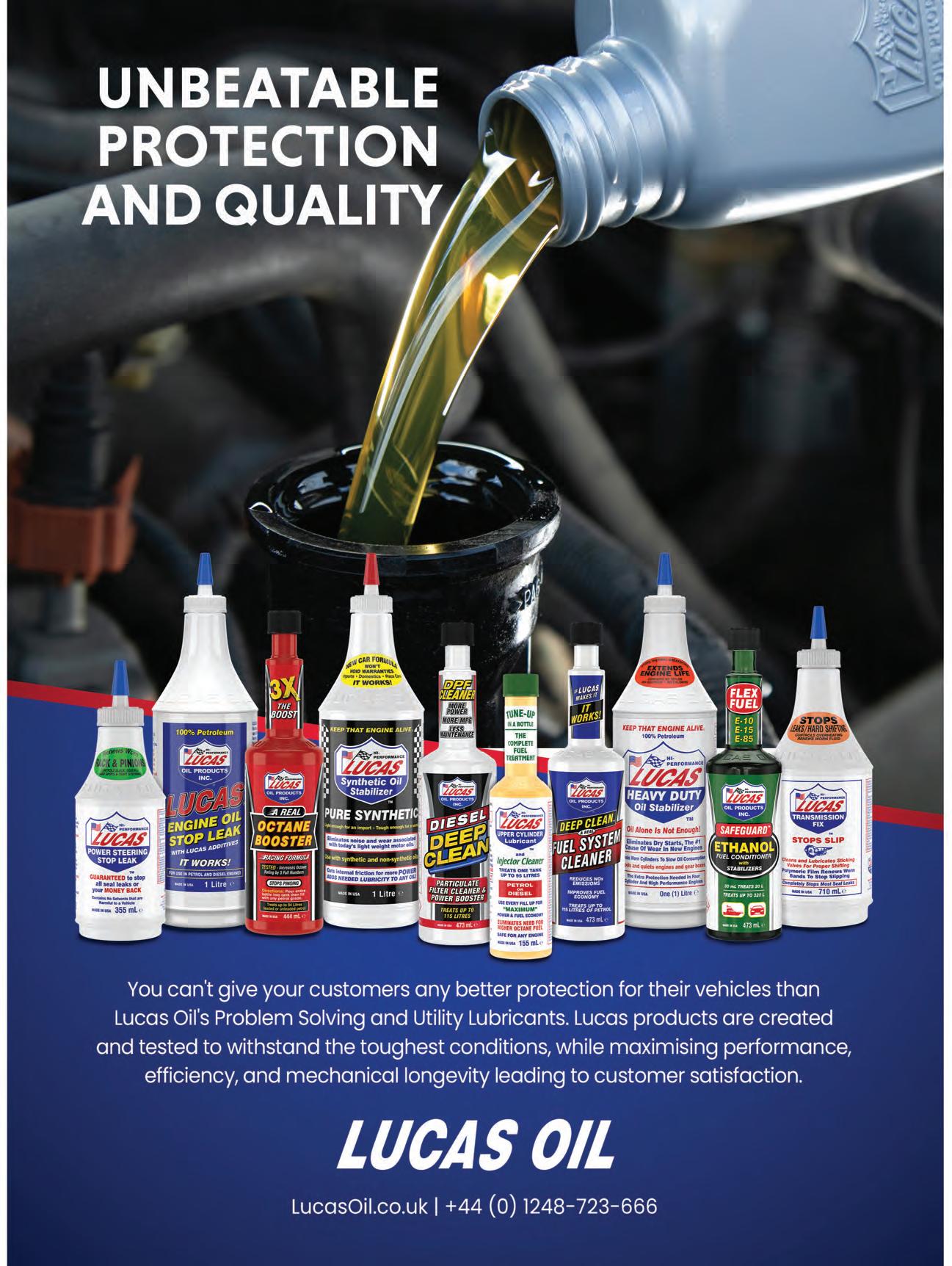
























 In pictures: Motul has been announced as a Circuit Partner & Event Sponsor of Wiltshire’s Castle Combe Circuit for the 2024 season.
In pictures: Motul has been announced as a Circuit Partner & Event Sponsor of Wiltshire’s Castle Combe Circuit for the 2024 season.





























































































































































